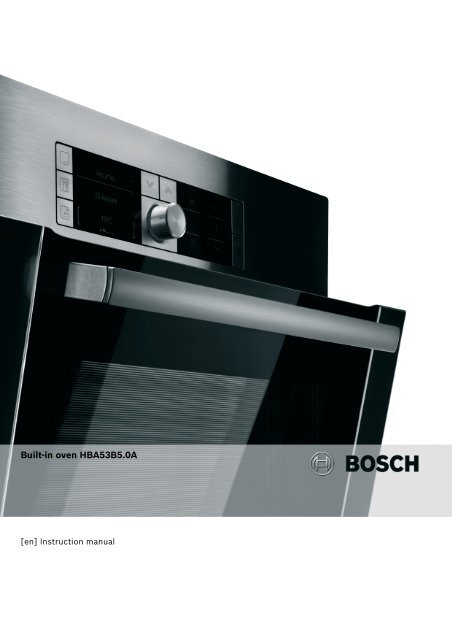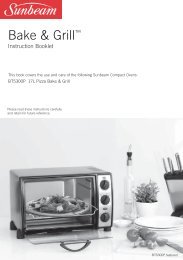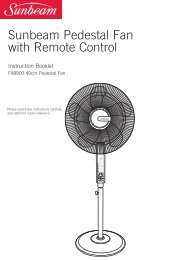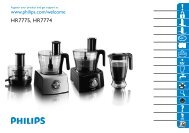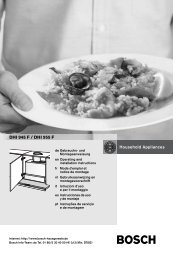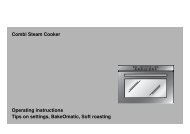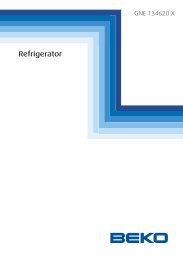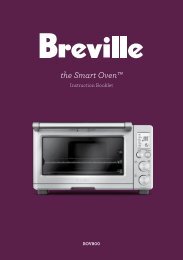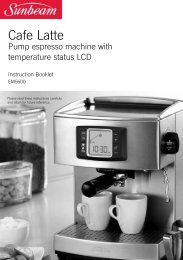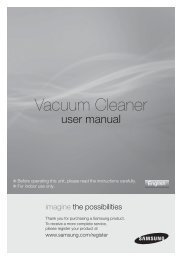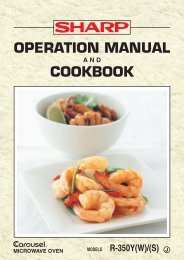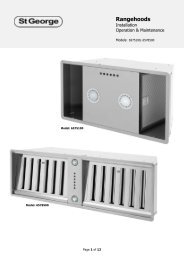Built-in oven HBA53B5.0A - Appliances Online
Built-in oven HBA53B5.0A - Appliances Online
Built-in oven HBA53B5.0A - Appliances Online
You also want an ePaper? Increase the reach of your titles
YUMPU automatically turns print PDFs into web optimized ePapers that Google loves.
<strong>Built</strong>-<strong>in</strong> <strong>oven</strong> <strong>HBA53B5.0A</strong><br />
[en] Instruction manual
Ú Table of contents[en] Instruction manual<br />
Safety precautions..................................................................... 4<br />
Before <strong>in</strong>stallation ...............................................................................4<br />
Safety notes .........................................................................................4<br />
Causes of damage .............................................................................4<br />
Your new <strong>oven</strong>............................................................................ 5<br />
Control panel .......................................................................................5<br />
Buttons and display............................................................................5<br />
Function selector.................................................................................5<br />
Temperature selector.........................................................................6<br />
Cook<strong>in</strong>g compartment .......................................................................6<br />
Accessories .........................................................................................6<br />
Before us<strong>in</strong>g the <strong>oven</strong> for the first time................................... 8<br />
Sett<strong>in</strong>g the clock .................................................................................8<br />
Heat<strong>in</strong>g up the <strong>oven</strong>...........................................................................8<br />
Clean<strong>in</strong>g the accessories..................................................................8<br />
Sett<strong>in</strong>g the <strong>oven</strong> ......................................................................... 8<br />
Type of heat<strong>in</strong>g and temperature ....................................................8<br />
Rapid heat<strong>in</strong>g ......................................................................................8<br />
Sett<strong>in</strong>g the time-sett<strong>in</strong>g options............................................... 9<br />
Timer .....................................................................................................9<br />
Cook<strong>in</strong>g time .......................................................................................9<br />
End time............................................................................................. 10<br />
Clock .................................................................................................. 10<br />
Childproof lock......................................................................... 10<br />
Chang<strong>in</strong>g the basic sett<strong>in</strong>gs................................................... 11<br />
Clean<strong>in</strong>g system ...................................................................... 11<br />
Before clean<strong>in</strong>g ................................................................................ 11<br />
Mak<strong>in</strong>g sett<strong>in</strong>gs ................................................................................ 11<br />
After clean<strong>in</strong>g.................................................................................... 11<br />
Care and clean<strong>in</strong>g.................................................................... 12<br />
Clean<strong>in</strong>g agents ............................................................................... 12<br />
Detach<strong>in</strong>g and refitt<strong>in</strong>g the rails.................................................... 12<br />
Detach<strong>in</strong>g and attach<strong>in</strong>g the <strong>oven</strong> door...................................... 13<br />
Remov<strong>in</strong>g and <strong>in</strong>stall<strong>in</strong>g the door panels ................................... 13<br />
Troubleshoot<strong>in</strong>g....................................................................... 14<br />
Malfunction table.............................................................................. 14<br />
Replac<strong>in</strong>g the bulb <strong>in</strong> the <strong>oven</strong> ceil<strong>in</strong>g light ............................... 15<br />
Glass cover....................................................................................... 15<br />
After-sales service................................................................... 15<br />
E number and FD number ............................................................. 15<br />
Energy and environment tips ................................................. 15<br />
Sav<strong>in</strong>g energy................................................................................... 15<br />
Environmentally-friendly disposal.................................................. 15<br />
Tested for you <strong>in</strong> our cook<strong>in</strong>g studio......................................16<br />
Cakes and pastries ......................................................................... 16<br />
Bak<strong>in</strong>g tips ........................................................................................ 18<br />
Meat, poultry, fish ............................................................................ 18<br />
Tips for roast<strong>in</strong>g and grill<strong>in</strong>g.......................................................... 21<br />
Bakes, grat<strong>in</strong>s, toast with topp<strong>in</strong>gs .............................................. 21<br />
Convenience products.................................................................... 22<br />
Special dishes .................................................................................. 22<br />
Defrost ............................................................................................... 23<br />
Dry<strong>in</strong>g................................................................................................. 23<br />
Preserv<strong>in</strong>g ......................................................................................... 23<br />
Acrylamide <strong>in</strong> foodstuffs .........................................................24<br />
Test dishes ................................................................................24<br />
Bak<strong>in</strong>g................................................................................................ 24<br />
Grill<strong>in</strong>g................................................................................................ 25<br />
Produkt<strong>in</strong>fo<br />
Additional <strong>in</strong>formation on products, accessories, replacement<br />
parts and services can be found at www.bosch-home.com and<br />
<strong>in</strong> the onl<strong>in</strong>e shop www.bosch-eshop.com<br />
3
ã=Safety precautions<br />
Please read this <strong>in</strong>struction manual<br />
carefully. Please keep the <strong>in</strong>struction<br />
and <strong>in</strong>stallation manuals <strong>in</strong> a safe<br />
place. Please pass on these manuals<br />
to the new owner if you sell the<br />
appliance.<br />
Before <strong>in</strong>stallation<br />
Damage dur<strong>in</strong>g transport<br />
Check the appliance for damage after unpack<strong>in</strong>g it. Do not<br />
connect the appliance if it has been damaged <strong>in</strong> transit.<br />
Electrical connection<br />
Only a licensed expert may connect the appliance. You will lose<br />
your warranty entitlement <strong>in</strong> the event of any damage caused<br />
by <strong>in</strong>correct connection.<br />
Safety notes<br />
This appliance is <strong>in</strong>tended for domestic use only. This<br />
appliance must only be used for food preparation.<br />
Adults and children must not operate the appliance without<br />
supervision,<br />
■ if they are physically or mentally <strong>in</strong>capable of do<strong>in</strong>g so or<br />
■ if they have <strong>in</strong>sufficient knowledge or experience.<br />
Never let children play with the appliance.<br />
Hot cook<strong>in</strong>g compartment<br />
Risk of burns!<br />
■ Never touch the <strong>in</strong>terior surfaces of the cook<strong>in</strong>g compartment<br />
or the heat<strong>in</strong>g elements. Open the appliance door carefully.<br />
Hot steam may escape. Small children must be kept at a safe<br />
distance from the appliance.<br />
■ Never prepare food conta<strong>in</strong><strong>in</strong>g large quantities of dr<strong>in</strong>ks with<br />
a high alcohol content. Alcoholic vapours can catch fire <strong>in</strong> the<br />
cook<strong>in</strong>g compartment. Only use small quantities of dr<strong>in</strong>ks<br />
with a high alcohol content and open the appliance door<br />
carefully.<br />
Risk of fire!<br />
■ Never store combustible items <strong>in</strong> the cook<strong>in</strong>g compartment.<br />
Never open the appliance door if there is smoke <strong>in</strong>side.<br />
Switch off the appliance. Pull out the ma<strong>in</strong>s plug or switch off<br />
the circuit breaker <strong>in</strong> the fuse box.<br />
■ Do not place greaseproof paper loosely over accessories<br />
dur<strong>in</strong>g preheat<strong>in</strong>g. A draught is created when the appliance<br />
door is opened. The greaseproof paper may come <strong>in</strong>to<br />
contact with the heat<strong>in</strong>g element and catch fire. Always<br />
weight down the greaseproof paper with a dish or a bak<strong>in</strong>g<br />
t<strong>in</strong>. Only cover the surface required with greaseproof paper.<br />
The greaseproof paper must not protrude over the<br />
accessories.<br />
Risk of short circuit!<br />
Never trap connect<strong>in</strong>g cables of electrical appliances <strong>in</strong> the hot<br />
appliance door. The cable <strong>in</strong>sulation could melt.<br />
Risk of scald<strong>in</strong>g!<br />
Never pour water <strong>in</strong>to the hot cook<strong>in</strong>g compartment. This will<br />
produce hot steam.<br />
4<br />
Hot accessories and <strong>oven</strong>ware<br />
Risk of burns!<br />
Never remove <strong>oven</strong>ware or accessories from the cook<strong>in</strong>g<br />
compartment without an <strong>oven</strong> cloth or <strong>oven</strong> gloves.<br />
Improper repairs<br />
Risk of electric shock!<br />
Improper repairs are dangerous. Repairs may only be carried<br />
out by one of our tra<strong>in</strong>ed after-sales eng<strong>in</strong>eers. If the appliance<br />
is defective, pull out the ma<strong>in</strong>s plug or switch off the appliance<br />
at the circuit breaker <strong>in</strong> the fuse box. Call the aftersales<br />
service.<br />
Causes of damage<br />
Caution!<br />
■ Accessories, foil, greaseproof paper or <strong>oven</strong>ware on the<br />
cook<strong>in</strong>g compartment floor: do not place accessories on the<br />
cook<strong>in</strong>g compartment floor. Do not cover the cook<strong>in</strong>g<br />
compartment floor with any sort of foil or greaseproof paper.<br />
Do not place <strong>oven</strong>ware on the cook<strong>in</strong>g compartment floor if a<br />
temperature of over 50 ºC has been set. This will cause heat<br />
to accumulate. The bak<strong>in</strong>g and roast<strong>in</strong>g times will no longer<br />
be correct and the enamel will be damaged.<br />
■ Water <strong>in</strong> a hot cook<strong>in</strong>g compartment: do not pour water <strong>in</strong>to<br />
the cook<strong>in</strong>g compartment when it is hot. This will cause<br />
steam. The temperature change can cause damage to the<br />
enamel.<br />
■ Moist food: do not store moist food <strong>in</strong> the cook<strong>in</strong>g<br />
compartment when it is closed for prolonged periods This will<br />
damage the enamel.<br />
■ Fruit juice: when bak<strong>in</strong>g particularly juicy fruit pies, do not<br />
pack the bak<strong>in</strong>g tray too generously. Fruit juice dripp<strong>in</strong>g from<br />
the bak<strong>in</strong>g tray leaves sta<strong>in</strong>s that cannot be removed. If<br />
possible, use the deeper universal pan.<br />
■ Cool<strong>in</strong>g with the appliance door open: only allow the cook<strong>in</strong>g<br />
compartment to cool when it is closed. Even if the appliance<br />
door is only open a little, front panels of adjacent units could<br />
be damaged over time.<br />
■ Heavily soiled <strong>oven</strong> seal: if the <strong>oven</strong> seal is heavily soiled, the<br />
<strong>oven</strong> door will no longer close properly when the <strong>oven</strong> is <strong>in</strong><br />
operation. The fronts of adjacent units could be damaged.<br />
Always keep the <strong>oven</strong> seal clean.<br />
■ Oven door as a bear<strong>in</strong>g surface: do not stand or place<br />
objects on the <strong>oven</strong> door when it is open. Do not place<br />
<strong>oven</strong>ware or accessories on the <strong>oven</strong> door.<br />
■ Carry<strong>in</strong>g the appliance: do not carry or hold the appliance by<br />
the door handle. The door handle cannot support the weight<br />
of the appliance and could break.
Your new <strong>oven</strong><br />
Here you will learn about your new <strong>oven</strong>. The control panel and<br />
the <strong>in</strong>dividual operat<strong>in</strong>g controls are expla<strong>in</strong>ed. You will f<strong>in</strong>d<br />
<strong>in</strong>formation on the cook<strong>in</strong>g compartment and the accessories.<br />
Control knobs<br />
The control knobs are retractable. To lock it <strong>in</strong> or out, press the<br />
control knob <strong>in</strong> the off position.<br />
Buttons<br />
The sensors are located under the <strong>in</strong>dividual buttons. They<br />
must not be pressed too firmly. Only touch the correspond<strong>in</strong>g<br />
symbol.<br />
Buttons and display<br />
<br />
You can use the buttons to set various additional functions. You<br />
can read the values that you have set <strong>in</strong> the display.<br />
Button Use<br />
c Rapid heat<strong>in</strong>g Heats up the <strong>oven</strong> particularly<br />
quickly.<br />
u Clean<strong>in</strong>g system Clean<strong>in</strong>g system for the self-clean<strong>in</strong>g<br />
surfaces <strong>in</strong> the cook<strong>in</strong>g compartment.<br />
0 Time-sett<strong>in</strong>g options Selects the timer U, cook<strong>in</strong>g<br />
time r, end time p and clock 0.<br />
D Childproof lock Locks and unlocks the control<br />
panel.<br />
A M<strong>in</strong>us<br />
Decreases the set values.<br />
@ Plus<br />
Increases the set values.<br />
The time-sett<strong>in</strong>g option that is currently selected <strong>in</strong> the display<br />
is <strong>in</strong>dicated by the brackets [ ] around the correspond<strong>in</strong>g<br />
symbol. Exception: for the clock, the 0 symbol only lights up<br />
when you are mak<strong>in</strong>g changes.<br />
<br />
Control panel<br />
Here, you will see an overview of the control panel. All of the<br />
symbols never appear <strong>in</strong> the display at the same time.<br />
Depend<strong>in</strong>g on the appliance model, <strong>in</strong>dividual details may<br />
differ.<br />
<br />
Function selector<br />
Use the function selector to set the type of heat<strong>in</strong>g.<br />
Sett<strong>in</strong>g Use<br />
Û Off position The <strong>oven</strong> switches off.<br />
< 3D hot air* For cakes and pastries on one to<br />
three levels. The fan distributes the<br />
heat from the heat<strong>in</strong>g r<strong>in</strong>g <strong>in</strong> the<br />
back panel evenly around the<br />
cook<strong>in</strong>g compartment.<br />
% Top/bottom heat<strong>in</strong>g For cakes, bakes and lean jo<strong>in</strong>ts of<br />
meat (e.g. beef or game) on one<br />
level. Heat is emitted evenly from<br />
the top and bottom.<br />
6 Pizza sett<strong>in</strong>g For the quick preparation of frozen<br />
products without preheat<strong>in</strong>g,<br />
e.g. pizza, chips or strudel. The<br />
bottom heat<strong>in</strong>g element and the<br />
r<strong>in</strong>g heat<strong>in</strong>g element <strong>in</strong> the back<br />
panel heat up.<br />
7 Hot air grill<strong>in</strong>g For roast<strong>in</strong>g meat, poultry and<br />
whole fish. The grill element and<br />
the fan switch on and off alternately.<br />
The fan causes the hot air<br />
to circulate around the dish.<br />
( Grill, large area For grill<strong>in</strong>g steaks, sausages,<br />
bread and pieces of fish. The<br />
whole area below the grill heat<strong>in</strong>g<br />
element becomes hot.<br />
* Grill, small area For grill<strong>in</strong>g small amounts of<br />
steaks, sausages, bread and<br />
pieces of fish. The centre part of<br />
the grill element becomes hot.<br />
$ Bottom heat<strong>in</strong>g For preserv<strong>in</strong>g, brown<strong>in</strong>g and f<strong>in</strong>al<br />
bak<strong>in</strong>g stage. The heat is emitted<br />
from below.<br />
B Defrost For defrost<strong>in</strong>g, e.g. meat, poultry,<br />
bread and cakes. The fan causes<br />
the warm air to circulate around<br />
the dish.<br />
^ Oven light Switches on the <strong>oven</strong> light.<br />
* Type of heat<strong>in</strong>g used to determ<strong>in</strong>e the energy efficiency class<br />
<strong>in</strong> accordance with EN50304.<br />
5
When you make sett<strong>in</strong>gs, the <strong>oven</strong> light <strong>in</strong> the cook<strong>in</strong>g<br />
compartment switches on.<br />
Temperature selector<br />
Use the temperature selector to set the temperature, grill<br />
sett<strong>in</strong>g or clean<strong>in</strong>g sett<strong>in</strong>g.<br />
Sett<strong>in</strong>g Mean<strong>in</strong>g<br />
Ú Off position The <strong>oven</strong> does not heat up.<br />
50-270 Temperature<br />
range<br />
When the <strong>oven</strong> is heat<strong>in</strong>g, the t symbol lights up <strong>in</strong> the<br />
display. It goes out dur<strong>in</strong>g pauses <strong>in</strong> the heat<strong>in</strong>g. For the<br />
Defrost B type of heat<strong>in</strong>g, the symbol does not light up.<br />
Cook<strong>in</strong>g compartment<br />
The <strong>oven</strong> light is located <strong>in</strong> the cook<strong>in</strong>g compartment. A cool<strong>in</strong>g<br />
fan protects the <strong>oven</strong> from overheat<strong>in</strong>g.<br />
Oven light<br />
Dur<strong>in</strong>g operation, the <strong>oven</strong> light <strong>in</strong> the cook<strong>in</strong>g compartment is<br />
on. The ^ sett<strong>in</strong>g on the function selector can be used to<br />
switch on the light without heat<strong>in</strong>g the <strong>oven</strong>.<br />
Cool<strong>in</strong>g fan<br />
The cool<strong>in</strong>g fan switches on and off as required. The hot air<br />
escapes above the door. Caution: do not cover the ventilation<br />
slots. Otherwise the <strong>oven</strong> will overheat.<br />
So that the cook<strong>in</strong>g compartment cools down more quickly<br />
after operation, the cool<strong>in</strong>g fan cont<strong>in</strong>ues to run for a certa<strong>in</strong><br />
period afterwards.<br />
6<br />
The temperature <strong>in</strong> the cook<strong>in</strong>g<br />
compartment <strong>in</strong> °C.<br />
I, II, III Grill sett<strong>in</strong>gs The grill sett<strong>in</strong>gs for the small *<br />
and large ( area grills.<br />
I = sett<strong>in</strong>g 1, low<br />
II = sett<strong>in</strong>g 2, medium<br />
III = sett<strong>in</strong>g 3, high<br />
s Clean<strong>in</strong>g sett<strong>in</strong>g The sett<strong>in</strong>g for the clean<strong>in</strong>g system.<br />
Accessories<br />
The accessories can be <strong>in</strong>serted <strong>in</strong>to the <strong>oven</strong> at 5 different<br />
levels.<br />
You can pull out the accessories two thirds of the way without<br />
them tipp<strong>in</strong>g. This allows dishes to be removed easily.<br />
<br />
<br />
<br />
<br />
<br />
The accessories can become deformed when they get hot. As<br />
soon as they have cooled down, the deformation disappears<br />
with no effect on the function.<br />
You can buy accessories from the after-sales service, from<br />
specialist retailers or onl<strong>in</strong>e. Please specify the HEZ number.<br />
Wire rack<br />
For <strong>oven</strong>ware, cake t<strong>in</strong>s, jo<strong>in</strong>ts,<br />
grilled items and frozen meals.<br />
Insert the wire rack with the curvature<br />
po<strong>in</strong>t<strong>in</strong>g downward ¾.<br />
Enamel bak<strong>in</strong>g tray<br />
For cakes and biscuits.<br />
Push the bak<strong>in</strong>g tray <strong>in</strong>to the <strong>oven</strong><br />
with the slop<strong>in</strong>g edge fac<strong>in</strong>g<br />
towards the <strong>oven</strong> door.<br />
Universal pan<br />
For moist cakes, pastries, frozen<br />
meals and large jo<strong>in</strong>ts. It can also<br />
be used to catch dripp<strong>in</strong>g fat when<br />
grill<strong>in</strong>g directly on the wire rack.<br />
Slide the universal pan <strong>in</strong>to the <strong>oven</strong><br />
with the slop<strong>in</strong>g edge fac<strong>in</strong>g the<br />
<strong>oven</strong> door.<br />
Grill tray<br />
Use for grill<strong>in</strong>g <strong>in</strong> place of the wire<br />
rack or as a splatter guard, so that<br />
the <strong>oven</strong> does not become very<br />
dirty. Only use the grill tray <strong>in</strong> the<br />
universal pan.<br />
Grill<strong>in</strong>g on the grill tray: only use at<br />
shelf height 1, 2 or 3.<br />
Us<strong>in</strong>g the grill tray as a splash<br />
guard: Insert the universal pan with<br />
the grill tray under the wire rack.<br />
Special accessories<br />
You can purchase special accessories from the after-sales<br />
service or specialist retailers. You will f<strong>in</strong>d a comprehensive<br />
range of products for your <strong>oven</strong> <strong>in</strong> our brochures and on the<br />
Internet. The availability of special accessories and whether it is<br />
possible to order them onl<strong>in</strong>e may vary depend<strong>in</strong>g on your<br />
country. Please see the sales brochures for more details.<br />
Not all optional accessories are suitable for every appliance.<br />
When purchas<strong>in</strong>g, please always quote the exact identification<br />
number (E no.) for your appliance.<br />
Special accessories HEZ number Use<br />
Wire rack HEZ334000 For <strong>oven</strong>ware, cake t<strong>in</strong>s, jo<strong>in</strong>ts, grilled items and frozen meals.<br />
Enamel bak<strong>in</strong>g tray HEZ331000 For cakes and biscuits.<br />
Push the bak<strong>in</strong>g tray <strong>in</strong>to the <strong>oven</strong> with the slop<strong>in</strong>g edge fac<strong>in</strong>g<br />
towards the <strong>oven</strong> door.
Special accessories HEZ number Use<br />
Universal pan HEZ332000 For moist cakes, pastries, frozen meals and large jo<strong>in</strong>ts. It can<br />
also be used to catch dripp<strong>in</strong>g fat when grill<strong>in</strong>g directly on the<br />
wire rack.<br />
Slide the universal pan <strong>in</strong>to the <strong>oven</strong> with the slop<strong>in</strong>g edge fac<strong>in</strong>g<br />
the <strong>oven</strong> door.<br />
Insert grid HEZ324000 For roast<strong>in</strong>g. Always place the grid <strong>in</strong> the universal pan. This<br />
ensures that dripp<strong>in</strong>g fat and meat juices are collected.<br />
Grill tray HEZ325000 Use for grill<strong>in</strong>g <strong>in</strong> place of the wire rack or as a splatter guard,<br />
so that the <strong>oven</strong> does not become very dirty. Only use the grill<br />
tray <strong>in</strong> the universal pan.<br />
Grill<strong>in</strong>g on the grill tray: only use at shelf height 1, 2 and 3.<br />
Us<strong>in</strong>g the grill tray as a splash guard: Insert the universal pan<br />
with the grill tray under the wire rack.<br />
Glass pan HEZ336000 A deep bak<strong>in</strong>g tray made of glass. Can also be used as a serv<strong>in</strong>g<br />
dish.<br />
Pizza tray HEZ317000 Ideal for pizza, frozen foods or large round cakes. You can use<br />
the pizza tray <strong>in</strong>stead of the universal pan. Place the bak<strong>in</strong>g<br />
tray on the wire rack and proceed accord<strong>in</strong>g to the details <strong>in</strong><br />
the tables.<br />
Bakestone HEZ327000 The bakestone is perfect for prepar<strong>in</strong>g home-made bread,<br />
bread rolls and pizzas which need to have a crispy base. The<br />
bakestone must always be preheated to the recommended<br />
temperature.<br />
Enamel bak<strong>in</strong>g tray with non-stick coat<strong>in</strong>g HEZ331010 Cakes and biscuits can be removed more easily from the bak<strong>in</strong>g<br />
tray. Push the bak<strong>in</strong>g tray <strong>in</strong>to the <strong>oven</strong> with the slop<strong>in</strong>g<br />
edge fac<strong>in</strong>g towards the <strong>oven</strong> door.<br />
Universal pan with non-stick coat<strong>in</strong>g HEZ332010 Moist cakes, pastries, frozen meals and large roasts can be<br />
removed more easily from the universal pan. Slide the universal<br />
pan <strong>in</strong>to the <strong>oven</strong> with the slop<strong>in</strong>g edge fac<strong>in</strong>g the <strong>oven</strong><br />
door.<br />
Profi extra-deep pan with <strong>in</strong>sert grid HEZ333000 Ideally suited for prepar<strong>in</strong>g large amounts.<br />
Lid for the Profi extra-deep pan HEZ333001 The lid converts the Profi extra-deep pan <strong>in</strong>to the Profi roast<strong>in</strong>g<br />
dish.<br />
Glass roast<strong>in</strong>g dish HEZ915001 The glass roast<strong>in</strong>g dish is suitable for pot roasts and casseroles<br />
that are cooked <strong>in</strong> the <strong>oven</strong>. It is ideally suited to automatic<br />
programmes or automatic roast<strong>in</strong>g.<br />
Metal roast<strong>in</strong>g dish HEZ6000 The roast<strong>in</strong>g dish is <strong>in</strong>tended for use on the extended cook<strong>in</strong>g<br />
zone of the glass ceramic hob. It is suitable for the sensor<br />
cook<strong>in</strong>g system as well as for automatic programmes or automatic<br />
roast<strong>in</strong>g. The roast<strong>in</strong>g dish is enamel on the outside with<br />
a non-stick coat<strong>in</strong>g on the <strong>in</strong>side.<br />
Telescopic shelf x3 HEZ338353 The pull-out rails at levels 1, 2 and 3 allow you to pull accessories<br />
out further without them tipp<strong>in</strong>g.<br />
Steam filter HEZ329000 You can retrofit this <strong>in</strong> your <strong>oven</strong>. The steam filter filters out<br />
grease particles from the exhaust air, thereby reduc<strong>in</strong>g odours.<br />
Only for appliances with a 6, 7 or 8 as the second digit <strong>in</strong> the E<br />
No. (e.g. HBA38B750)<br />
System steamer HEZ24D300 For easy preparation of vegetables and fish.<br />
After-sales service products<br />
You can obta<strong>in</strong> suitable care and clean<strong>in</strong>g agents and other<br />
accessories for your domestic appliances from the after-sales<br />
service, specialist retailers or (<strong>in</strong> some countries) onl<strong>in</strong>e via the<br />
eShop. Please specify the relevant product number.<br />
Clean<strong>in</strong>g cloths for sta<strong>in</strong>less-steel surfaces Product no. 311134 Reduces the build-up of dirt. Impregnated with a special oil for<br />
perfect ma<strong>in</strong>tenance of your appliance's sta<strong>in</strong>less-steel surfaces.<br />
Oven and grill clean<strong>in</strong>g gel Product no. 463582 For clean<strong>in</strong>g the cook<strong>in</strong>g compartment. The gel is odourless.<br />
Microfibre cloth with honeycomb structure Product no. 460770 Especially suitable for clean<strong>in</strong>g delicate surfaces, such<br />
as glass, glass ceramic, sta<strong>in</strong>less steel or alum<strong>in</strong>ium. The<br />
microfibre cloth removes liquid and grease deposits <strong>in</strong> one go.<br />
Door lock Product no. 612594 To prevent children from open<strong>in</strong>g the <strong>oven</strong> door. The locks on<br />
different types of appliance door are screwed <strong>in</strong> differently.<br />
See the <strong>in</strong>formation sheet supplied with the door lock.<br />
7
Before us<strong>in</strong>g the <strong>oven</strong> for the first time<br />
In this section, you can f<strong>in</strong>d out what you must do before us<strong>in</strong>g<br />
your <strong>oven</strong> to prepare food for the first time. First read the<br />
section on Safety <strong>in</strong>formation.<br />
Sett<strong>in</strong>g the clock<br />
After the appliance has been connected, the 0 symbol and<br />
four zeros light up <strong>in</strong> the display. Set the clock.<br />
1. Press the 0 button.<br />
The time 12:00 is shown <strong>in</strong> the display.<br />
2. Use the @ or A button to set the clock.<br />
After a few seconds, the time that has been set is adopted.<br />
Sett<strong>in</strong>g the <strong>oven</strong><br />
There are various ways <strong>in</strong> which you can set your <strong>oven</strong>. Here<br />
we will expla<strong>in</strong> how you can select the desired type of heat<strong>in</strong>g<br />
and temperature or grill sett<strong>in</strong>g. You can select the <strong>oven</strong><br />
cook<strong>in</strong>g time and end time for your dish. Please refer to the<br />
section on Sett<strong>in</strong>g the time-sett<strong>in</strong>g options.<br />
Type of heat<strong>in</strong>g and temperature<br />
Example <strong>in</strong> the picture: % Top/bottom heat<strong>in</strong>g at 190 °C.<br />
1. The function selector is used to set the type of heat<strong>in</strong>g.<br />
2. Set the temperature or grill sett<strong>in</strong>g us<strong>in</strong>g the temperature<br />
selector.<br />
The <strong>oven</strong> beg<strong>in</strong>s to heat up.<br />
Switch<strong>in</strong>g off the <strong>oven</strong><br />
Turn the function selector to the off position.<br />
Chang<strong>in</strong>g the sett<strong>in</strong>gs<br />
The type of heat<strong>in</strong>g and temperature or grill sett<strong>in</strong>g can be<br />
changed at any time us<strong>in</strong>g their respective selectors.<br />
8<br />
Heat<strong>in</strong>g up the <strong>oven</strong><br />
To remove the new cooker smell, heat up the <strong>oven</strong> when it is<br />
empty and closed. An hour of Top/bottom heat<strong>in</strong>g % at<br />
240 °C is ideal for this purpose. Ensure that no packag<strong>in</strong>g<br />
remnants have been left <strong>in</strong> the cook<strong>in</strong>g compartment.<br />
1. Use the function selector to set Top/bottom heat<strong>in</strong>g %.<br />
2. Set the temperature selector to 240 °C.<br />
After an hour, switch off the <strong>oven</strong>. To do so, turn the function<br />
selector to the off position.<br />
Clean<strong>in</strong>g the accessories<br />
Before you use the accessories for the first time, clean them<br />
thoroughly with hot soapy water and a soft dish cloth.<br />
Rapid heat<strong>in</strong>g<br />
With rapid heat<strong>in</strong>g, your <strong>oven</strong> reaches the temperature selected<br />
particularly quickly.<br />
Use rapid heat<strong>in</strong>g when temperatures above 100 °C are<br />
selected. The follow<strong>in</strong>g types of heat<strong>in</strong>g are suitable:<br />
■ < 3D hot air<br />
■ % Top/bottom heat<strong>in</strong>g<br />
■ 6 Pizza sett<strong>in</strong>g<br />
To ensure an even cook<strong>in</strong>g result, do not place your dish <strong>in</strong> the<br />
cook<strong>in</strong>g compartment until rapid heat<strong>in</strong>g is complete.<br />
1. Set the type of heat<strong>in</strong>g and temperature.<br />
2. Press the c button.<br />
The c symbol lights up <strong>in</strong> the display. The <strong>oven</strong> beg<strong>in</strong>s to<br />
heat up.<br />
The rapid heat<strong>in</strong>g process is complete<br />
A signal sounds. The c symbol <strong>in</strong> the display goes out. Put<br />
your dish <strong>in</strong> the <strong>oven</strong>.<br />
Cancell<strong>in</strong>g rapid heat<strong>in</strong>g<br />
Press the c button. The c symbol <strong>in</strong> the display goes out.
Sett<strong>in</strong>g the time-sett<strong>in</strong>g options<br />
Your <strong>oven</strong> has various time-sett<strong>in</strong>g options. You can use the 0<br />
button to call up the menu and switch between the <strong>in</strong>dividual<br />
functions. All the time symbols are lit when you can make<br />
sett<strong>in</strong>gs. The brackets [ ] show you which time-sett<strong>in</strong>g option<br />
you have currently selected. A time-sett<strong>in</strong>g option which has<br />
already been set can be changed directly with the @ or A<br />
button when the relevant time symbol is <strong>in</strong> brackets.<br />
Timer<br />
You can use the timer as a kitchen timer. It runs <strong>in</strong>dependently<br />
of the <strong>oven</strong>. The timer has its own signal. In this way, you can<br />
tell whether it is the timer or a cook<strong>in</strong>g time which has elapsed.<br />
1. Press the 0 button once.<br />
The time symbols light up <strong>in</strong> the display and the brackets are<br />
around U.<br />
2. Use the @ or A button to set the timer duration.<br />
Default value for @button = 10 m<strong>in</strong>utes<br />
Default value for Abutton = 5 m<strong>in</strong>utes<br />
After a few seconds, the time sett<strong>in</strong>g is adopted. The timer<br />
starts. The [U] symbol lights up <strong>in</strong> the display and the timer<br />
duration counts down. The other time symbols go out.<br />
The timer duration has elapsed<br />
A signal sounds. 00:00 is shown <strong>in</strong> the display. Use the 0<br />
button to switch off the timer.<br />
Chang<strong>in</strong>g the timer duration<br />
Use the @ or A button to change the timer duration. After a few<br />
seconds, the change is adopted.<br />
Cancell<strong>in</strong>g the timer duration<br />
Use the A button to reset the timer duration to 00:00. The<br />
change will be adopted after a few seconds. The timer is<br />
switched off.<br />
Check<strong>in</strong>g the time sett<strong>in</strong>gs<br />
If several time-sett<strong>in</strong>g options are set, the relevant symbols are<br />
illum<strong>in</strong>ated on the display. The symbol for the time-sett<strong>in</strong>g<br />
option that is visible <strong>in</strong> the display is shown <strong>in</strong> brackets.<br />
To call up the U timer, r cook<strong>in</strong>g time, p end time or 0<br />
clock, press the 0 button repeatedly until the brackets are<br />
around the relevant symbol. The display shows the value for a<br />
few seconds.<br />
Cook<strong>in</strong>g time<br />
The cook<strong>in</strong>g time for your dish can be set on the <strong>oven</strong>. When<br />
the cook<strong>in</strong>g time has elapsed, the <strong>oven</strong> switches itself off<br />
automatically. This means that you do not have to <strong>in</strong>terrupt<br />
other work to switch off the <strong>oven</strong>. The cook<strong>in</strong>g time cannot be<br />
accidentally exceeded.<br />
Example <strong>in</strong> the picture: cook<strong>in</strong>g time 45 m<strong>in</strong>utes.<br />
1. Use the function selector to set the type of heat<strong>in</strong>g.<br />
2. Set the temperature or grill sett<strong>in</strong>g us<strong>in</strong>g the temperature<br />
selector.<br />
3. Press the 0 button twice.<br />
00:00 is shown <strong>in</strong> the display. The time symbols light up and<br />
the brackets are around r.<br />
4. Use the @ or A button to set the cook<strong>in</strong>g time.<br />
Default value for @ button = 30 m<strong>in</strong>utes<br />
Default value for A button = 10 m<strong>in</strong>utes<br />
The <strong>oven</strong> will start up after a few seconds. The cook<strong>in</strong>g time<br />
counts down <strong>in</strong> the display and the [r] symbol lights up. The<br />
other time symbols go out.<br />
The cook<strong>in</strong>g time has elapsed<br />
A signal sounds. The <strong>oven</strong> stops heat<strong>in</strong>g. 00:00 is shown <strong>in</strong> the<br />
display. Press the 0 button. You can set a new cook<strong>in</strong>g time<br />
us<strong>in</strong>g the @ or A button. Or press the 0 button twice and turn<br />
the function selector to the off position. The <strong>oven</strong> switches off.<br />
Chang<strong>in</strong>g the cook<strong>in</strong>g time<br />
Use the @ or A button to change the cook<strong>in</strong>g time. After a few<br />
seconds, the change is adopted. If the timer has been set,<br />
press the 0 button beforehand.<br />
Cancell<strong>in</strong>g the cook<strong>in</strong>g time<br />
Use the A button to reset the cook<strong>in</strong>g time to 00:00. After a few<br />
seconds, the change is adopted. The cook<strong>in</strong>g time is<br />
cancelled. If the timer has been set, press the 0 button<br />
beforehand.<br />
Check<strong>in</strong>g the time sett<strong>in</strong>gs<br />
If several time-sett<strong>in</strong>g options are set, the relevant symbols are<br />
illum<strong>in</strong>ated on the display. The symbol for the time-sett<strong>in</strong>g<br />
option that is visible <strong>in</strong> the display is shown <strong>in</strong> brackets.<br />
To call up the U timer, r cook<strong>in</strong>g time, p end time or 0<br />
clock, press the 0 button repeatedly until the brackets are<br />
around the relevant symbol. The display shows the value for a<br />
few seconds.<br />
9
End time<br />
You can change the time at which you wish your dish to be<br />
ready. The <strong>oven</strong> starts automatically and f<strong>in</strong>ishes at the desired<br />
time. You can, for example, put your dish <strong>in</strong> the cook<strong>in</strong>g<br />
compartment <strong>in</strong> the morn<strong>in</strong>g and set the cook<strong>in</strong>g time so that it<br />
is ready at lunch time.<br />
Ensure that food is not left <strong>in</strong> the cook<strong>in</strong>g compartment for too<br />
long as it may spoil.<br />
Example <strong>in</strong> the picture: it is 10:30 am, the cook<strong>in</strong>g time is<br />
45 m<strong>in</strong>utes and the <strong>oven</strong> is required to f<strong>in</strong>ish cook<strong>in</strong>g at<br />
12:30 pm.<br />
1. Adjust the function selector.<br />
2. Set the temperature selector.<br />
3. Press the 0 button twice.<br />
4. Use the @ or A button to set the cook<strong>in</strong>g time.<br />
5. Press the 0 button.<br />
The brackets are around p. The time when the dish will be<br />
ready is displayed.<br />
6. Use the @ or A button to set a later end time.<br />
After a few seconds, the <strong>oven</strong> adopts the sett<strong>in</strong>gs and switches<br />
to standby position. The time at which the dish will be ready is<br />
shown <strong>in</strong> the display and the p symbol is <strong>in</strong> brackets. The U<br />
and 0 symbols go out. When the <strong>oven</strong> starts, you can see the<br />
cook<strong>in</strong>g time count<strong>in</strong>g down <strong>in</strong> the display and the r symbol is<br />
<strong>in</strong> brackets. The p symbol goes out.<br />
Childproof lock<br />
The <strong>oven</strong> has a childproof lock to prevent children switch<strong>in</strong>g it<br />
on accidentally.<br />
The <strong>oven</strong> will not react to any sett<strong>in</strong>gs. The timer and clock can<br />
also be set when the childproof lock has been activated.<br />
If the type of heat<strong>in</strong>g and temperature or grill sett<strong>in</strong>g have been<br />
set, the childproof lock <strong>in</strong>terrupts the heat<strong>in</strong>g.<br />
Activat<strong>in</strong>g the childproof lock<br />
No cook<strong>in</strong>g time or end time should have been set.<br />
Press and hold the D button for approx. four seconds.<br />
The D symbol appears <strong>in</strong> the display. The childproof lock is<br />
activated.<br />
10<br />
The cook<strong>in</strong>g time has elapsed<br />
A signal sounds. The <strong>oven</strong> stops heat<strong>in</strong>g. 00:00 is shown <strong>in</strong> the<br />
display. Press the 0 button. You can set a new cook<strong>in</strong>g time<br />
us<strong>in</strong>g the @ or A button. Or press the 0 button twice and turn<br />
the function selector to the off position. The <strong>oven</strong> switches off.<br />
Chang<strong>in</strong>g the end time<br />
Use the @ or A button to change the end time. After a few<br />
seconds, the change is adopted. If the timer has been set, first<br />
press the 0 button twice. Do not change the end time if the<br />
cook<strong>in</strong>g time has already started to elapse. The cook<strong>in</strong>g result<br />
would no longer be correct.<br />
Cancell<strong>in</strong>g the end time<br />
Use the A button to reset the end time to the current time. After<br />
a few seconds, the change is adopted. The <strong>oven</strong> starts. If the<br />
timer has been set, first press the 0 button twice.<br />
Check<strong>in</strong>g the time sett<strong>in</strong>gs<br />
If several time-sett<strong>in</strong>g options are set, the relevant symbols are<br />
illum<strong>in</strong>ated on the display. The symbol for the time-sett<strong>in</strong>g<br />
option that is visible <strong>in</strong> the display is shown <strong>in</strong> brackets.<br />
To call up the U timer, r cook<strong>in</strong>g time, p end time or 0<br />
clock, press the 0 button repeatedly until the brackets are<br />
around the relevant symbol. The display shows the value for a<br />
few seconds.<br />
Clock<br />
After the appliance is connected or follow<strong>in</strong>g a power cut,<br />
the 0 symbol and four zeros light up <strong>in</strong> the display. Set the<br />
clock.<br />
1. Press the 0 button.<br />
The time 12:00 is shown <strong>in</strong> the display.<br />
2. Use the @ or A button to set the clock.<br />
After a few seconds, the time that has been set is adopted.<br />
Chang<strong>in</strong>g the clock<br />
No other time-sett<strong>in</strong>g option should have been set.<br />
1. Press the 0 button four times.<br />
The time symbols light up <strong>in</strong> the display and the brackets are<br />
around 0.<br />
2. Use the @ or A button to change the clock.<br />
After a few seconds, the time that has been set is adopted.<br />
Hid<strong>in</strong>g the clock<br />
You can hide the clock. For more <strong>in</strong>formation, please refer to<br />
the section Chang<strong>in</strong>g the basic sett<strong>in</strong>gs.<br />
Deactivat<strong>in</strong>g the childproof lock<br />
Press and hold the D button for approx. four seconds.<br />
The D symbol goes out <strong>in</strong> the display. The childproof lock is<br />
deactivated.
Chang<strong>in</strong>g the basic sett<strong>in</strong>gs<br />
Your <strong>oven</strong> has various basic sett<strong>in</strong>gs. These sett<strong>in</strong>gs can be<br />
customised to suit your requirements.<br />
Basic sett<strong>in</strong>g Selection 1 Selection 2 Selection 3<br />
c1 Clock display always* only with<br />
the 0 button<br />
-<br />
c2 Signal duration upon<br />
completion of a<br />
cook<strong>in</strong>g time or<br />
timer period<br />
c3 Wait<strong>in</strong>g time until a<br />
sett<strong>in</strong>g is applied<br />
* Factory sett<strong>in</strong>g<br />
No other time-sett<strong>in</strong>g option should have been set.<br />
Clean<strong>in</strong>g system<br />
The clean<strong>in</strong>g system regenerates the self-clean<strong>in</strong>g surfaces <strong>in</strong><br />
the cook<strong>in</strong>g compartment.<br />
The back wall, ceil<strong>in</strong>g and side walls of the cook<strong>in</strong>g<br />
compartment are coated with a highly porous ceramic layer.<br />
This coat<strong>in</strong>g absorbs and dis<strong>in</strong>tegrates splashes from bak<strong>in</strong>g<br />
and roast<strong>in</strong>g while the <strong>oven</strong> is <strong>in</strong> operation. If these selfclean<strong>in</strong>g<br />
surfaces no longer clean themselves adequately, they<br />
can be regenerated with the clean<strong>in</strong>g system.<br />
Before clean<strong>in</strong>g<br />
Remove accessories and cookware from the cook<strong>in</strong>g<br />
compartment.<br />
Clean<strong>in</strong>g the cook<strong>in</strong>g compartment floor<br />
Before you set the clean<strong>in</strong>g system, clean the surfaces <strong>in</strong> the<br />
cook<strong>in</strong>g compartment that are not self-clean<strong>in</strong>g. Otherwise,<br />
sta<strong>in</strong>s will develop that it is not possible to remove.<br />
Use a dish cloth and hot soapy water or a v<strong>in</strong>egar solution. If<br />
there are heavy deposits of dirt, use a sta<strong>in</strong>less steel scour<strong>in</strong>g<br />
pad or <strong>oven</strong> cleaner. Only use when the cook<strong>in</strong>g compartment<br />
is cold. Never treat the self-clean<strong>in</strong>g surfaces with a scour<strong>in</strong>g<br />
pad or <strong>oven</strong> cleaner.<br />
Mak<strong>in</strong>g sett<strong>in</strong>gs<br />
approx.<br />
10 second<br />
s<br />
approx.<br />
2seconds<br />
Clean<strong>in</strong>g takes approximately one hour.<br />
approx.<br />
2 m<strong>in</strong>utes*<br />
approx.<br />
5seconds*<br />
approx.<br />
5m<strong>in</strong>utes<br />
approx.<br />
10 second<br />
s<br />
1. Set the function selector to < 3D hot air.<br />
2. Set the temperature selector to s.<br />
3. Press theu button.<br />
The u symbol lights up <strong>in</strong> the display. The time at which the<br />
clean<strong>in</strong>g will end appears and the p symbol is <strong>in</strong> brackets.<br />
Clean<strong>in</strong>g will start after a few seconds. You will see the time<br />
count<strong>in</strong>g down and the r symbol will be <strong>in</strong> brackets. The p<br />
symbol goes out.<br />
Clean<strong>in</strong>g is f<strong>in</strong>ished<br />
A signal sounds. The <strong>oven</strong> stops heat<strong>in</strong>g. 00:00 is shown <strong>in</strong> the<br />
display. Press the 0 button twice and turn the function selector<br />
to the off position. The <strong>oven</strong> switches off.<br />
Cancell<strong>in</strong>g clean<strong>in</strong>g<br />
Press the u button and turn the function selector to the off<br />
position. The <strong>oven</strong> switches off.<br />
1. Press and hold the 0 button for approx. 4 seconds.<br />
The current basic sett<strong>in</strong>g for the clock display is shown <strong>in</strong> the<br />
display, e.g. c1 1 for selection 1.<br />
2. Use the @ or A button to change the basic sett<strong>in</strong>g.<br />
3. Confirm by press<strong>in</strong>g the 0 button.<br />
The next basic sett<strong>in</strong>g appears <strong>in</strong> the display. You can scroll<br />
through all levels with the 0 button and change the sett<strong>in</strong>g<br />
with the @ or A button.<br />
4. To f<strong>in</strong>ish, press and hold the 0 button for approx. 4 seconds.<br />
All basic sett<strong>in</strong>gs are applied.<br />
You may change the basic sett<strong>in</strong>gs at any time.<br />
Sett<strong>in</strong>g a later end time<br />
You can delay the time at which the clean<strong>in</strong>g programme is due<br />
to f<strong>in</strong>ish. For <strong>in</strong>stance, you can set the clean<strong>in</strong>g programme to<br />
run at night so that you can use your <strong>oven</strong> dur<strong>in</strong>g the day.<br />
Make the sett<strong>in</strong>gs as described <strong>in</strong> steps 1 to 3. Before clean<strong>in</strong>g<br />
starts, use the @ or A button to set a later end time.<br />
The <strong>oven</strong> switches to standby. The display shows the time at<br />
which the clean<strong>in</strong>g will f<strong>in</strong>ish and the p symbol is <strong>in</strong> brackets.<br />
When clean<strong>in</strong>g starts, you can see the time count<strong>in</strong>g down <strong>in</strong><br />
the display and the r symbol is <strong>in</strong> brackets. The p symbol<br />
goes out.<br />
After clean<strong>in</strong>g<br />
When the cook<strong>in</strong>g compartment has cooled down completely,<br />
wipe the salt residues off the self-clean<strong>in</strong>g surfaces with a<br />
damp cloth.<br />
11
Care and clean<strong>in</strong>g<br />
With good care and clean<strong>in</strong>g, your <strong>oven</strong> will rema<strong>in</strong> clean and<br />
fully-function<strong>in</strong>g for a long time to come. Here we will expla<strong>in</strong><br />
how to ma<strong>in</strong>ta<strong>in</strong> and clean your <strong>oven</strong> correctly.<br />
Notes<br />
■ Slight differences <strong>in</strong> the colours on the front of the <strong>oven</strong> are<br />
caused by the use of different materials, such as glass,<br />
plastic and metal.<br />
■ Shadows on the door panel which look like streaks, are<br />
caused by reflections made by the <strong>oven</strong> light.<br />
■ Enamel is baked on at very high temperatures. This can<br />
cause some slight colour variations. This is normal and does<br />
not affect their function. The edges of th<strong>in</strong> trays cannot be<br />
completely enamelled. As a result, these edges can be<br />
rough. This will not impair the anti-corrosion protection.<br />
Clean<strong>in</strong>g agents<br />
To ensure that the different surfaces are not damaged by us<strong>in</strong>g<br />
the wrong clean<strong>in</strong>g agent, observe the <strong>in</strong>formation <strong>in</strong> the table.<br />
Do not use<br />
■ sharp or abrasive clean<strong>in</strong>g agents,<br />
■ clean<strong>in</strong>g agents with a high concentration of alcohol,<br />
■ hard scour<strong>in</strong>g pads or sponges,<br />
■ high-pressure cleaners or steam cleaners.<br />
Wash new sponge cloths thoroughly before use.<br />
Area Clean<strong>in</strong>g agents<br />
Oven front Hot soapy water:<br />
Clean with a dish cloth and dry with a<br />
soft cloth. Do not use glass cleaners or<br />
glass scrapers.<br />
Sta<strong>in</strong>less steel Hot soapy water:<br />
Clean with a dish cloth and dry with a<br />
soft cloth. Remove flecks of limescale,<br />
grease, starch and album<strong>in</strong> (e.g. egg<br />
white) immediately. Corrosion can form<br />
under such residues.<br />
Special sta<strong>in</strong>less steel clean<strong>in</strong>g products<br />
suitable for warm surfaces are available<br />
from our after-sales service or from<br />
specialist retailers. Apply a th<strong>in</strong> layer of<br />
the clean<strong>in</strong>g product with a soft cloth.<br />
Door panels Glass cleaner:<br />
Clean with a soft cloth. Do not use a<br />
glass scraper.<br />
Glass cover for the<br />
<strong>oven</strong> light<br />
Seal<br />
Do not remove.<br />
12<br />
Hot soapy water:<br />
Clean with a dish cloth.<br />
Hot soapy water:<br />
Clean with a dish cloth. Do not scour.<br />
Shelves Hot soapy water:<br />
Soak and clean with a dish cloth or<br />
brush.<br />
Telescopic shelves Hot soapy water:<br />
Clean with a dish cloth or a brush. Do<br />
not soak or clean <strong>in</strong> the dishwasher.<br />
Accessories Hot soapy water:<br />
Soak and clean with a dish cloth or<br />
brush.<br />
Clean<strong>in</strong>g the self-clean<strong>in</strong>g surfaces <strong>in</strong> the cook<strong>in</strong>g<br />
compartment<br />
The back wall, ceil<strong>in</strong>g and side walls of the cook<strong>in</strong>g<br />
compartment are coated with a highly porous ceramic layer.<br />
This coat<strong>in</strong>g absorbs and dis<strong>in</strong>tegrates splashes from bak<strong>in</strong>g<br />
and roast<strong>in</strong>g while the <strong>oven</strong> is <strong>in</strong> operation. The higher the<br />
temperature and the longer the <strong>oven</strong> is <strong>in</strong> operation, the better<br />
the result will be.<br />
Never treat the self-clean<strong>in</strong>g surfaces with <strong>oven</strong> cleaner.<br />
If the self-clean<strong>in</strong>g surfaces no longer clean sufficiently, they<br />
can be regenerated with the clean<strong>in</strong>g system. For more<br />
<strong>in</strong>formation, please see the Clean<strong>in</strong>g system section.<br />
Light discolouration of the coat<strong>in</strong>g does not affect automatic<br />
self-clean<strong>in</strong>g.<br />
Caution!<br />
■ Never use abrasive clean<strong>in</strong>g agents. You will scratch or<br />
destroy the highly porous coat<strong>in</strong>g.<br />
■ Never treat the ceramic coat<strong>in</strong>g with <strong>oven</strong> cleaner. If <strong>oven</strong><br />
cleaner accidentally gets onto it, remove it immediately with a<br />
sponge and plenty of water.<br />
Clean<strong>in</strong>g the cook<strong>in</strong>g compartment floor<br />
Use a dish cloth and hot soapy water or a v<strong>in</strong>egar solution.<br />
If there are heavy deposits of dirt, use a sta<strong>in</strong>less steel scour<strong>in</strong>g<br />
pad or <strong>oven</strong> cleaner. Only use when the cook<strong>in</strong>g compartment<br />
is cold. Never treat the self-clean<strong>in</strong>g surfaces with a scour<strong>in</strong>g<br />
pad or <strong>oven</strong> cleaner.<br />
Detach<strong>in</strong>g and refitt<strong>in</strong>g the rails<br />
The rails can be removed for clean<strong>in</strong>g. The <strong>oven</strong> must have<br />
cooled down.<br />
Detach<strong>in</strong>g the rails<br />
1. Lift up the front of the rail<br />
2. and unhook it (figure A).<br />
3. Then pull the whole rail forward<br />
4. and remove it (Fig. B).<br />
<br />
<br />
<br />
Clean the rails with clean<strong>in</strong>g agent and a sponge. For stubborn<br />
deposits of dirt, use a brush.
Refitt<strong>in</strong>g the rails<br />
1. First <strong>in</strong>sert the rail <strong>in</strong>to the rear socket, press it to the back<br />
slightly (figure A),<br />
2. and then hook it <strong>in</strong>to the front socket (figure B).<br />
<br />
The rails fit both the left and right sides. The k<strong>in</strong>ked section<br />
must always be at the bottom.<br />
Detach<strong>in</strong>g and attach<strong>in</strong>g the <strong>oven</strong> door<br />
For clean<strong>in</strong>g purposes and to remove the door panels, you can<br />
detach the <strong>oven</strong> door.<br />
The <strong>oven</strong> door h<strong>in</strong>ges each have a lock<strong>in</strong>g lever. When the<br />
lock<strong>in</strong>g levers are closed (figure A), the <strong>oven</strong> door is secured <strong>in</strong><br />
place. It cannot be detached. When the lock<strong>in</strong>g levers are open<br />
<strong>in</strong> order to detach the <strong>oven</strong> door (Fig. B), the h<strong>in</strong>ges are locked.<br />
They cannot snap shut.<br />
<br />
ã=Risk of <strong>in</strong>jury!<br />
Whenever the h<strong>in</strong>ges are not locked, they snap shut with great<br />
force. Ensure that the lock<strong>in</strong>g levers are always fully closed or,<br />
when detach<strong>in</strong>g the <strong>oven</strong> door, fully open.<br />
Detach<strong>in</strong>g the door<br />
1. Open the <strong>oven</strong> door fully.<br />
2. Fold up the two lock<strong>in</strong>g levers on the left and right (figure A).<br />
3. Close the <strong>oven</strong> door as far as the limit stop. With both hands,<br />
grip the door on the left and right-hand sides. Close the door<br />
a little further and pull it out (figure B).<br />
<br />
<br />
<br />
<br />
Attach<strong>in</strong>g the door<br />
Reattach the <strong>oven</strong> door <strong>in</strong> the reverse sequence to removal.<br />
1. When attach<strong>in</strong>g the <strong>oven</strong> door, ensure that both h<strong>in</strong>ges are<br />
<strong>in</strong>serted straight <strong>in</strong>to the open<strong>in</strong>g (figure A).<br />
2. The notch on the h<strong>in</strong>ge must engage on both sides (figure B).<br />
<br />
3. Fold back both lock<strong>in</strong>g levers (figure C). Close the <strong>oven</strong><br />
door.<br />
<br />
ã=Risk of <strong>in</strong>jury!<br />
If the <strong>oven</strong> door falls out accidentally or a h<strong>in</strong>ge snaps shut, do<br />
not reach <strong>in</strong>to the h<strong>in</strong>ge. Call the aftersales service.<br />
Remov<strong>in</strong>g and <strong>in</strong>stall<strong>in</strong>g the door panels<br />
To facilitate clean<strong>in</strong>g, you can remove the glass panels from the<br />
<strong>oven</strong> door.<br />
When remov<strong>in</strong>g the <strong>in</strong>ner panels, pay attention to the order <strong>in</strong><br />
which the panels are removed. In order to reassemble the<br />
panels <strong>in</strong> the correct sequence, follow the number which<br />
appears on each panel.<br />
Removal<br />
1. Detach the <strong>oven</strong> door and lay on a cloth with the handle<br />
fac<strong>in</strong>g down.<br />
2. Unscrew the cover at the top of the <strong>oven</strong> door. To do this,<br />
undo the left and right screws (fig. A).<br />
3. Lift the top panel up and out (fig. B).<br />
<br />
<br />
<br />
13
4. Unscrew the reta<strong>in</strong><strong>in</strong>g clips on the right and left and remove<br />
them (fig. C). Remove the middle panel.<br />
<br />
5. Pull the lower panel diagonally upwards and out.<br />
Clean the panels with glass cleaner and a soft cloth.<br />
Do not use sharp or abrasive materials or a glass scraper. This<br />
may damage the glass.<br />
Fitt<strong>in</strong>g<br />
When fitt<strong>in</strong>g, make sure that the letter<strong>in</strong>g "right above" is upside<br />
down at the bottom left on both panels.<br />
1. Insert the lower panel diagonally towards the back (fig. A).<br />
2. Insert the centre panel (fig. B).<br />
Troubleshoot<strong>in</strong>g<br />
Malfunctions often have simple explanations. Refer to the table<br />
before call<strong>in</strong>g the after-sales service as you may be able to<br />
remedy the fault yourself.<br />
Malfunction table<br />
If a dish doesn't turn out as well as you had hoped, refer to the<br />
section Tested for you <strong>in</strong> our cook<strong>in</strong>g studio, where you will<br />
f<strong>in</strong>d plenty of cook<strong>in</strong>g tips and tricks.<br />
Problem Possible cause Remedy/<strong>in</strong>formation<br />
The <strong>oven</strong> does<br />
not work.<br />
0 and zeros<br />
light up <strong>in</strong> the<br />
display.<br />
The <strong>oven</strong> does<br />
not heat up.<br />
Error messages<br />
If an error message with “ appears, press the 0 button. The<br />
message disappears. A time function that has been set is<br />
cleared. If the error message does not disappear, please<br />
contact the after-sales service.<br />
You can take remedial action yourself if the follow<strong>in</strong>g error<br />
message is displayed.<br />
14<br />
The circuit<br />
breaker is<br />
defective.<br />
Look <strong>in</strong> the fuse box and<br />
check that the circuit<br />
breaker is <strong>in</strong> work<strong>in</strong>g order.<br />
Power cut Check whether the kitchen<br />
light or other kitchen appliances<br />
are work<strong>in</strong>g.<br />
Power cut Reset the clock.<br />
There is dust on<br />
the contacts.<br />
Turn the control knobs back<br />
and forth several times.<br />
<br />
3. Stick the reta<strong>in</strong><strong>in</strong>g clips onto the right and left-hand side of<br />
the panel, align<strong>in</strong>g them so that the carriers are over the<br />
screw holes, and then screw <strong>in</strong> place (fig. C).<br />
<br />
4. Insert the uppermost panel diagonally towards the back. The<br />
smooth surface must face outwards.<br />
5. Put the cover back <strong>in</strong> place and screw it on.<br />
6. Attach the <strong>oven</strong> door.<br />
Do not use the <strong>oven</strong> aga<strong>in</strong> until the panels have been<br />
correctly fitted.<br />
Error message Possible cause Remedy/<strong>in</strong>formation<br />
“‹‚‚ A button was<br />
depressed for<br />
too long or is<br />
covered up.<br />
ã=Risk of electric shock!<br />
Incorrect repairs are dangerous. Repairs may only be carried<br />
out by one of our tra<strong>in</strong>ed after-sales eng<strong>in</strong>eers.<br />
<br />
Press all buttons <strong>in</strong>dividually.<br />
Check whether any buttons<br />
are jammed, covered<br />
up or soiled.
Replac<strong>in</strong>g the bulb <strong>in</strong> the <strong>oven</strong> ceil<strong>in</strong>g light<br />
If the bulb <strong>in</strong> the <strong>oven</strong> light fails, it must be replaced. Heatresistant,<br />
40 watt spare bulbs can be obta<strong>in</strong>ed from our aftersales<br />
service or a specialist retailer. Only use these bulbs.<br />
ã=Risk of electric shock!<br />
Switch off the circuit breaker <strong>in</strong> the fuse box.<br />
1. Place a tea towel <strong>in</strong> the <strong>oven</strong> when it is cold to prevent<br />
damage.<br />
2. Unscrew the glass cover by turn<strong>in</strong>g it anti-clockwise.<br />
After-sales service<br />
Our after-sales service is there for you if your appliance needs<br />
to be repaired. We will always f<strong>in</strong>d the right solution <strong>in</strong> order to<br />
avoid unnecessary visits from a service technician.<br />
E number and FD number<br />
When call<strong>in</strong>g us, please give the product number (E no.) and<br />
the production number (FD no.) so that we can provide you with<br />
the correct advice. The rat<strong>in</strong>g plate conta<strong>in</strong><strong>in</strong>g these numbers<br />
can be found on the right-hand side of the <strong>oven</strong> door. You can<br />
make a note of the numbers of your appliance and the<br />
telephone number of the after-sales service <strong>in</strong> the space below<br />
to save time should it be required.<br />
E no.<br />
Energy and environment tips<br />
Here you can f<strong>in</strong>d tips on how to save energy when bak<strong>in</strong>g and<br />
roast<strong>in</strong>g and how to dispose of your appliance properly.<br />
Sav<strong>in</strong>g energy<br />
FD no.<br />
■ Only preheat the <strong>oven</strong> if this is specified <strong>in</strong> the recipe or <strong>in</strong><br />
the operat<strong>in</strong>g <strong>in</strong>struction tables.<br />
■ Use dark, black lacquered or enamelled bak<strong>in</strong>g t<strong>in</strong>s. They<br />
absorb the heat particularly well.<br />
■ Open the <strong>oven</strong> door as <strong>in</strong>frequently as possible while you are<br />
cook<strong>in</strong>g, bak<strong>in</strong>g or roast<strong>in</strong>g.<br />
■ It is best to bake several cakes one after the other. The <strong>oven</strong><br />
is still warm. This reduces the bak<strong>in</strong>g time for the second<br />
cake. You can also place two loaf t<strong>in</strong>s next to each other.<br />
■ For longer cook<strong>in</strong>g times, you can switch the <strong>oven</strong> off<br />
10 m<strong>in</strong>utes before the end of the cook<strong>in</strong>g time and use the<br />
residual heat to f<strong>in</strong>ish cook<strong>in</strong>g.<br />
3. Replace the bulb with one of the same type.<br />
4. Screw the glass cover back <strong>in</strong>.<br />
5. Remove the tea towel and switch on the circuit breaker.<br />
Glass cover<br />
You must replace a damaged glass cover. Suitable glass<br />
covers may be obta<strong>in</strong>ed from the after-sales service. Please<br />
specify the E number and FD number of your appliance.<br />
After-sales service O<br />
Please note that there will be a fee for a visit by a service<br />
technician <strong>in</strong> the event of a malfunction, even dur<strong>in</strong>g the<br />
warranty period.<br />
Please f<strong>in</strong>d the contact data of all countries <strong>in</strong> the enclosed<br />
customer service list.<br />
To book an eng<strong>in</strong>eer visit and product advice<br />
GB 0844 8928979<br />
Calls from a BT landl<strong>in</strong>e will be charged at up to 3<br />
pence per m<strong>in</strong>ute. A call set-up fee of up to 6 pence may<br />
apply.<br />
IE 01450 2655<br />
Trust the expertise of the manufacturer, and rest assured that<br />
the repair will be carried out by tra<strong>in</strong>ed service technicians<br />
us<strong>in</strong>g orig<strong>in</strong>al spare parts for your domestic appliance.<br />
Environmentally-friendly disposal<br />
Dispose of packag<strong>in</strong>g <strong>in</strong> an environmentally-friendly manner.<br />
This appliance complies with European Directive<br />
2002/96/EC on Waste Electrical and Electronic<br />
Equipment (WEEE). The directive gives a framework for<br />
the collection and recycl<strong>in</strong>g of old appliances, which is<br />
valid across the EU.<br />
15
Tested for you <strong>in</strong> our cook<strong>in</strong>g studio<br />
Here you will f<strong>in</strong>d a selection of dishes and the ideal sett<strong>in</strong>gs for<br />
them. We will show you which type of heat<strong>in</strong>g and which<br />
temperature are best suited for your dish. You can f<strong>in</strong>d<br />
<strong>in</strong>formation about suitable accessories and the height at which<br />
they should be <strong>in</strong>serted. There are also tips about cookware<br />
and preparation methods.<br />
Notes<br />
■ The values <strong>in</strong> the table always apply to dishes placed <strong>in</strong>to the<br />
cook<strong>in</strong>g compartment when it is cold and empty.<br />
Only preheat the appliance if the table specifies that you<br />
should do so. Do not l<strong>in</strong>e the accessories with greaseproof<br />
paper until after they have been preheated.<br />
■ The times specified <strong>in</strong> the tables are guidel<strong>in</strong>es only. They will<br />
depend on the quality and composition of the food.<br />
■ Use the accessories supplied. Additional accessories may be<br />
obta<strong>in</strong>ed as special accessories from specialist retailers or<br />
from the after-sales service.<br />
Before us<strong>in</strong>g the <strong>oven</strong>, remove any unnecessary accessories<br />
and <strong>oven</strong>ware from the cook<strong>in</strong>g compartment.<br />
■ Always use <strong>oven</strong> gloves when tak<strong>in</strong>g hot accessories or<br />
<strong>oven</strong>ware out of the cook<strong>in</strong>g compartment.<br />
Cakes and pastries<br />
Bak<strong>in</strong>g on one level<br />
When bak<strong>in</strong>g cakes, the best results can be achieved us<strong>in</strong>g %<br />
Top/bottom heat<strong>in</strong>g.<br />
When bak<strong>in</strong>g with : 3D hot air, use the follow<strong>in</strong>g shelf heights<br />
for the accessory:<br />
■ Cakes <strong>in</strong> t<strong>in</strong>s: level 2<br />
■ Cakes on trays: level 3<br />
Bak<strong>in</strong>g on two or more levels<br />
Use : 3D hot air.<br />
Shelf heights for bak<strong>in</strong>g on 2 levels:<br />
■ Universal pan: level 3<br />
■ Bak<strong>in</strong>g tray: level 1<br />
Shelf heights for bak<strong>in</strong>g on 3 levels:<br />
■ Bak<strong>in</strong>g tray: level 5<br />
Cakes <strong>in</strong> t<strong>in</strong>s T<strong>in</strong> Level Type of<br />
heat<strong>in</strong>g<br />
16<br />
■ Universal pan: level 3<br />
■ Bak<strong>in</strong>g tray: level 1<br />
Bak<strong>in</strong>g trays that are placed <strong>in</strong> the <strong>oven</strong> at the same time will<br />
not necessarily be ready at the same time.<br />
The tables show numerous suggestions for your dishes.<br />
If you are bak<strong>in</strong>g with 3 cake/loaf t<strong>in</strong>s at the same time, place<br />
these on the wire racks as <strong>in</strong>dicated <strong>in</strong> the picture.<br />
Bak<strong>in</strong>g t<strong>in</strong>s<br />
It is best to use dark-coloured metal bak<strong>in</strong>g t<strong>in</strong>s.<br />
Bak<strong>in</strong>g times are <strong>in</strong>creased when light-coloured bak<strong>in</strong>g t<strong>in</strong>s<br />
made of th<strong>in</strong> metal or glass dishes are used, and cakes do not<br />
brown so evenly.<br />
If you wish to use silicone bak<strong>in</strong>g t<strong>in</strong>s, use the <strong>in</strong>formation and<br />
recipes provided by the manufacturer as a guide. Silicone<br />
bak<strong>in</strong>g t<strong>in</strong>s are often smaller than normal t<strong>in</strong>s. The amount of<br />
mixture and recipe <strong>in</strong>structions may differ.<br />
Tables<br />
The tables show the ideal type of heat<strong>in</strong>g for the various cakes<br />
and pastries. The temperature and bak<strong>in</strong>g time depend on the<br />
amount and composition of the mixture. This is why<br />
temperature ranges are given <strong>in</strong> the tables. You should try the<br />
lower temperature first, s<strong>in</strong>ce a lower temperature results <strong>in</strong><br />
more even brown<strong>in</strong>g. You can <strong>in</strong>crease the temperature next<br />
time if necessary.<br />
If you preheat the <strong>oven</strong>, the bak<strong>in</strong>g time is shortened by 5 to 10<br />
m<strong>in</strong>utes.<br />
Additional <strong>in</strong>formation can be found <strong>in</strong> the Bak<strong>in</strong>g tips section<br />
follow<strong>in</strong>g the tables.<br />
Temperature<br />
<strong>in</strong> °C<br />
Sponge cake, simple R<strong>in</strong>g t<strong>in</strong>/round t<strong>in</strong> 2 : 160-180 50-60<br />
3 loaf t<strong>in</strong>s 3+1 : 140-160 60-80<br />
Sponge cake, delicate R<strong>in</strong>g t<strong>in</strong>/round t<strong>in</strong> 2 % 150-170 65-75<br />
Flan base, sponge Flan t<strong>in</strong> 3 % 160-180 20-30<br />
Delicate fruit flan, sponge Spr<strong>in</strong>gform/r<strong>in</strong>g t<strong>in</strong> 2 % 160-180 50-60<br />
Sponge base, 2 eggs (preheat) Flan t<strong>in</strong> 2 % 160-180 20-30<br />
Sponge flan, 6 eggs (preheat) Spr<strong>in</strong>gform cake t<strong>in</strong> 2 % 160-180 40-50<br />
Shortcrust pastry base with crust Spr<strong>in</strong>gform cake t<strong>in</strong> 1 % 170-190 25-35<br />
Fruit tart/cheesecake, pastry base* Spr<strong>in</strong>gform cake t<strong>in</strong> 1 % 170-190 70-90<br />
Swiss flan Pizza tray 1 % 220-240 35-45<br />
R<strong>in</strong>g cake R<strong>in</strong>g cake t<strong>in</strong> 2 % 150-170 60-70<br />
Pizza, th<strong>in</strong> base with light topp<strong>in</strong>g (preheat)<br />
Pizza tray 1 % 250-270 10-15<br />
Savoury cakes* Spr<strong>in</strong>gform cake t<strong>in</strong> 1 % 180-200 45-55<br />
* Turn off the <strong>oven</strong> and allow cakes to cool for an additional 20 m<strong>in</strong>utes with the <strong>oven</strong> door closed.<br />
Cook<strong>in</strong>g time<br />
<strong>in</strong> m<strong>in</strong>utes
Cakes on trays Accessories Level Type of<br />
heat<strong>in</strong>g<br />
Temperature<br />
<strong>in</strong> °C<br />
Cook<strong>in</strong>g time<br />
<strong>in</strong> m<strong>in</strong>utes<br />
Sponge with dry topp<strong>in</strong>g Bak<strong>in</strong>g tray 2 % 170-190 20-30<br />
Universal pan + bak<strong>in</strong>g<br />
tray<br />
3+1 : 150-170 35-45<br />
Sponge with moist topp<strong>in</strong>g (fruit) Universal pan 2 % 180-200 25-35<br />
Universal pan + bak<strong>in</strong>g<br />
tray<br />
3+1 : 140-160 40-50<br />
Yeast dough with dry topp<strong>in</strong>g Bak<strong>in</strong>g tray 3 % 170-190 25-35<br />
Universal pan + bak<strong>in</strong>g<br />
tray<br />
3+1 : 150-170 35-45<br />
Yeast dough with moist topp<strong>in</strong>g (fruit) Universal pan 3 % 160-180 40-50<br />
Universal pan + bak<strong>in</strong>g<br />
tray<br />
3+1 : 150-170 50-60<br />
Shortcrust pastry with dry topp<strong>in</strong>g Bak<strong>in</strong>g tray 2 % 170-190 20-30<br />
Shortcrust pastry with moist topp<strong>in</strong>g<br />
(fruit)<br />
Universal pan 2 % 170-190 60-70<br />
Swiss flan Universal pan 1 % 210-230 40-50<br />
Swiss roll (preheat) Bak<strong>in</strong>g tray 2 % 170-190 15-20<br />
Plaited loaf with 500 g flour Bak<strong>in</strong>g tray 2 % 170-190 25-35<br />
Stollen with 500 g flour Bak<strong>in</strong>g tray 3 % 160-180 60-70<br />
Stollen with 1 kg flour Bak<strong>in</strong>g tray 3 % 140-160 90-100<br />
Strudel, sweet Universal pan 2 % 190-210 55-65<br />
Pizza Bak<strong>in</strong>g tray 2 % 210-230 25-35<br />
Universal pan + bak<strong>in</strong>g<br />
tray<br />
3+1 : 180-200 40-50<br />
Tarte flambée (preheat) Universal pan 2 % 250-270 10-15<br />
Börek Universal pan 2 % 180-200 40-50<br />
Small baked items Accessories Level Type of<br />
heat<strong>in</strong>g<br />
Temperature<br />
<strong>in</strong> °C<br />
Cook<strong>in</strong>g time<br />
<strong>in</strong> m<strong>in</strong>utes<br />
Biscuits Bak<strong>in</strong>g tray 3 : 140-160 15-25<br />
Universal pan + bak<strong>in</strong>g tray 3+1 : 130-150 25-35<br />
2 bak<strong>in</strong>g trays + universal pan 5+3+1 : 130-150 30-40<br />
Viennese whirls (preheat) Bak<strong>in</strong>g tray 3 % 140-150 30-40<br />
Bak<strong>in</strong>g tray 3 : 140-150 30-40<br />
Universal pan + bak<strong>in</strong>g tray 3+1 : 140-150 30-45<br />
2 bak<strong>in</strong>g trays + universal pan 5+3+1 : 130-140 40-55<br />
Macaroons Bak<strong>in</strong>g tray 2 % 100-120 30-40<br />
Universal pan + bak<strong>in</strong>g tray 3+1 : 100-120 35-45<br />
2 bak<strong>in</strong>g trays + universal pan 5+3+1 : 100-120 40-50<br />
Mer<strong>in</strong>gue Bak<strong>in</strong>g tray 3 : 80-100 100-150<br />
Muff<strong>in</strong>s Wire rack with muff<strong>in</strong> tray 2 % 170-190 20-25<br />
2 wire racks with muff<strong>in</strong> trays 3+1 : 160-180 25-35<br />
Choux pastry Bak<strong>in</strong>g tray 2 % 210-230 30-40<br />
Puff pastry Bak<strong>in</strong>g tray 3 : 180-200 20-30<br />
Universal pan + bak<strong>in</strong>g tray 3+1 : 180-200 25-35<br />
2 bak<strong>in</strong>g trays + universal pan 5+3+1 : 170-190 35-45<br />
Leavened cake Bak<strong>in</strong>g tray 2 % 180-200 20-30<br />
Universal pan + bak<strong>in</strong>g tray 3+1 : 160-180 25-35<br />
17
Bread and rolls<br />
When bak<strong>in</strong>g bread, preheat the <strong>oven</strong>, unless <strong>in</strong>structions state<br />
otherwise.<br />
Bak<strong>in</strong>g tips<br />
Meat, poultry, fish<br />
Ovenware<br />
You may use any heatresistant <strong>oven</strong>ware. The universal pan is<br />
suitable for large roasts.<br />
Glass <strong>oven</strong>ware is the most suitable. Ensure that the lid of the<br />
roast<strong>in</strong>g dish fits well and closes properly.<br />
Add a little more liquid when us<strong>in</strong>g enamelled roast<strong>in</strong>g dishes.<br />
With roast<strong>in</strong>g dishes made of sta<strong>in</strong>less steel, brown<strong>in</strong>g is not so<br />
<strong>in</strong>tense and the meat may be somewhat less well cooked.<br />
Increase the cook<strong>in</strong>g times.<br />
Information <strong>in</strong> the tables:<br />
Ovenware without a lid = open<br />
Ovenware with a lid = closed<br />
Always place the <strong>oven</strong>ware <strong>in</strong> the centre of the wire rack.<br />
18<br />
Never pour water <strong>in</strong>to the hot <strong>oven</strong>.<br />
Bread and rolls Accessories Level Type of<br />
heat<strong>in</strong>g<br />
Temperature<br />
<strong>in</strong> °C<br />
Yeast bread with 1.2 kg flour Universal pan 2 % 270<br />
5<br />
200<br />
30-40<br />
Sourdough bread with 1.2 kg Universal pan 2 % 270<br />
8<br />
flour<br />
200<br />
35-45<br />
Flatbread Universal pan 2 % 270 10-15<br />
Bread rolls (do not preheat) Bak<strong>in</strong>g tray 3 % 200-220 20-30<br />
Rolls made with sweet yeast Bak<strong>in</strong>g tray 3 % 180-200 15-20<br />
dough<br />
Universal pan + bak<strong>in</strong>g tray 3+1 : 160-180 20-30<br />
You wish to bake accord<strong>in</strong>g to your own<br />
recipe.<br />
How to establish whether sponge cake<br />
is baked through.<br />
Use similar items <strong>in</strong> the bak<strong>in</strong>g tables as a guide.<br />
Cook<strong>in</strong>g time<br />
<strong>in</strong> m<strong>in</strong>utes<br />
Approximately 10 m<strong>in</strong>utes before the end of the bak<strong>in</strong>g time specified <strong>in</strong> the recipe, stick<br />
a cocktail stick <strong>in</strong>to the cake at the highest po<strong>in</strong>t. If the cocktail stick comes out clean,<br />
the cake is ready.<br />
The cake collapses. Use less fluid next time or set the <strong>oven</strong> temperature 10 degrees lower. Observe the<br />
specified mix<strong>in</strong>g times <strong>in</strong> the recipe.<br />
The cake has risen <strong>in</strong> the middle but is<br />
lower around the edge.<br />
Do not grease the sides of the spr<strong>in</strong>gform cake t<strong>in</strong>. After bak<strong>in</strong>g, loosen the cake carefully<br />
with a knife.<br />
The cake goes too dark on top. Place it lower <strong>in</strong> the <strong>oven</strong>, select a lower temperature and bake the cake for a little<br />
longer.<br />
The cake is too dry. When it is done, make small holes <strong>in</strong> the cake us<strong>in</strong>g a cocktail stick. Then drizzle fruit<br />
juice or an alcoholic beverage over it. Next time, select a temperature 10 degrees higher<br />
and reduce the bak<strong>in</strong>g time.<br />
The bread or cake (e.g. cheesecake)<br />
looks good, but is soggy on the <strong>in</strong>side<br />
(sticky, streaked with water).<br />
Use slightly less fluid next time and bake for slightly longer at a lower temperature. For<br />
cakes with a moist topp<strong>in</strong>g, bake the base first. Spr<strong>in</strong>kle it with almonds or bread crumbs<br />
and then place the topp<strong>in</strong>g on top. Please follow the recipe and bak<strong>in</strong>g times.<br />
The cake is unevenly browned. Select a slightly lower temperature to ensure that the cake is baked more evenly. Bake<br />
delicate pastries on one level us<strong>in</strong>g % Top/bottom heat<strong>in</strong>g. Protrud<strong>in</strong>g greaseproof<br />
paper can affect the air circulation. For this reason, always cut greaseproof paper to fit<br />
the bak<strong>in</strong>g tray.<br />
The bottom of a fruit cake is too light. Place the cake one level lower the next time.<br />
The fruit juice overflows. Next time, use the deeper universal pan, if you have one.<br />
Small baked items made out of yeast<br />
dough stick to one another when bak<strong>in</strong>g.<br />
You were bak<strong>in</strong>g on several levels. The<br />
items on the top bak<strong>in</strong>g tray are darker<br />
than that on the bottom bak<strong>in</strong>g tray.<br />
Condensation forms when you bake<br />
moist cakes.<br />
There should be a gap of approx. 2 cm around each item. This gives enough space for<br />
the baked items to expand well and turn brown on all sides.<br />
Always use : 3D hot air to bake on more than one level. Bak<strong>in</strong>g trays that are placed <strong>in</strong><br />
the <strong>oven</strong> at the same time will not necessarily be ready at the same time.<br />
Bak<strong>in</strong>g may result <strong>in</strong> the formation of water vapour, which escapes above the door. The<br />
steam may settle and form water droplets on the control panel or on the fronts of adjacent<br />
units. This is a natural process.<br />
Place hot glass <strong>oven</strong>ware on a dry mat after cook<strong>in</strong>g. The glass<br />
could crack if placed on a cold or wet surface.<br />
Roast<strong>in</strong>g<br />
Add <strong>in</strong> a little liquid if the meat is lean. Cover the base of the<br />
<strong>oven</strong>ware with approx. ½ cm of liquid.<br />
Add liquid generously for pot roasts. Cover the base of the<br />
<strong>oven</strong>ware with approx. 1 - 2 cm of liquid.<br />
The amount of liquid depends on the type of meat and the<br />
material the <strong>oven</strong>ware is made of. If prepar<strong>in</strong>g meat <strong>in</strong> an<br />
enamelled roast<strong>in</strong>g dish, it will need a little more liquid than if<br />
cooked <strong>in</strong> glass <strong>oven</strong>ware.<br />
Roast<strong>in</strong>g dishes made from sta<strong>in</strong>less steel are not ideal. The<br />
meat cooks more slowly and browns less fully. Use a higher<br />
temperature and/or a longer cook<strong>in</strong>g time.
Grill<strong>in</strong>g<br />
When grill<strong>in</strong>g, preheat the <strong>oven</strong> for approx. 3 m<strong>in</strong>utes, before<br />
plac<strong>in</strong>g the food <strong>in</strong>to the cook<strong>in</strong>g compartment.<br />
Always grill with the <strong>oven</strong> door closed.<br />
As far as possible, the pieces of food you are grill<strong>in</strong>g should be<br />
of equal thickness. This will allow them to brown evenly and<br />
rema<strong>in</strong> succulent and juicy.<br />
Turn the food you are grill<strong>in</strong>g after Z of the time.<br />
Do not add salt to steaks until they have been grilled.<br />
Place the food to be grilled directly on the wire rack. If you are<br />
grill<strong>in</strong>g a s<strong>in</strong>gle piece, the best results are achieved by plac<strong>in</strong>g<br />
it <strong>in</strong> the centre of the wire rack.<br />
The universal pan should also be <strong>in</strong>serted at level 1. The meat<br />
juices are collected <strong>in</strong> the pan and the <strong>oven</strong> is kept cleaner.<br />
Meat Weight Accessories and<br />
<strong>oven</strong>ware<br />
When grill<strong>in</strong>g, do not <strong>in</strong>sert the bak<strong>in</strong>g tray or universal pan at<br />
level 4 or 5. The high heat distorts it and the cook<strong>in</strong>g<br />
compartment can be damaged when remov<strong>in</strong>g it.<br />
The grill element switches on and off cont<strong>in</strong>ually. This is normal.<br />
The grill sett<strong>in</strong>g determ<strong>in</strong>es how frequently this will happen.<br />
Meat<br />
Turn pieces of meat halfway through the cook<strong>in</strong>g time.<br />
When the roast is ready, turn off the <strong>oven</strong> and allow it to rest for<br />
an additional 10 m<strong>in</strong>utes. This allows better distribution of the<br />
meat juices.<br />
After cook<strong>in</strong>g, wrap sirlo<strong>in</strong> <strong>in</strong> alum<strong>in</strong>ium foil and leave it to rest<br />
for 10 m<strong>in</strong>utes <strong>in</strong> the <strong>oven</strong>.<br />
For roast pork with a r<strong>in</strong>d, score the r<strong>in</strong>d <strong>in</strong> a crossways pattern,<br />
then lay the roast <strong>in</strong> the dish with the r<strong>in</strong>d at the bottom.<br />
Level Type of<br />
heat<strong>in</strong>g<br />
Temperature<br />
<strong>in</strong> °C, grill sett<strong>in</strong>g<br />
Beef<br />
Pot-roasted beef 1.0 kg covered 2 % 210-230 100<br />
1.5 kg 2 % 200-220 120<br />
2.0 kg 2 % 190-210 140<br />
Fillet of beef, medium 1.0 kg uncovered 2 % 210-230 60<br />
1.5 kg 2 % 200-220 80<br />
Sirlo<strong>in</strong>, medium 1.0 kg uncovered 1 4 220-240 60<br />
Steaks, 3 cm thick, medium wire rack + universal<br />
pan<br />
5+1 ( 3 15<br />
Veal<br />
Jo<strong>in</strong>t of veal 1.0 kg uncovered 2 % 190-210 110<br />
1.5 kg 2 % 180-200 130<br />
2.0 kg 2 % 170-190 150<br />
Knuckle of veal 1.5 kg uncovered 2 % 210-230 140<br />
Pork<br />
Jo<strong>in</strong>t without r<strong>in</strong>d (e.g. neck) 1.0 kg universal pan with 1 4 190-210 120<br />
1.5 kg<br />
grill tray<br />
1 4 180-200 150<br />
2.0 kg 1 4 170-190 170<br />
Jo<strong>in</strong>t with r<strong>in</strong>d (e.g. shoulder) 1.0 kg uncovered 1 4 190-210 130<br />
1.5 kg 1 4 180-200 160<br />
2.0 kg 1 4 170-190 190<br />
Fillet of pork 500 g wire rack + universal<br />
pan<br />
3+1 4 220-230 30<br />
Pork jo<strong>in</strong>t, lean 1.0 kg uncovered 2 % 200-220 120<br />
1.5 kg 2 % 190-210 140<br />
2.0 kg 2 % 180-200 160<br />
Smoked pork on the bone 1.0 kg covered 2 % 200-220 70<br />
Steaks, 2 cm thick wire rack + universal<br />
pan<br />
5+1 ( 3 20<br />
Pork medallions, 3 cm thick wire rack + universal<br />
pan<br />
5+1 ( 3 10<br />
Lamb<br />
Saddle of lamb on the bone 1.5 kg uncovered 2 4 190-210 60<br />
Leg of lamb, boned, medium 1.5 kg uncovered 1 4 150-170 120<br />
Game<br />
Saddle of venison on the bone 1.5 kg uncovered 2 % 200-220 50<br />
Cook<strong>in</strong>g time<br />
<strong>in</strong> m<strong>in</strong>utes<br />
19
Meat Weight Accessories and<br />
<strong>oven</strong>ware<br />
Leg of roe venison, boned 1.5 kg covered 2 % 210-230 100<br />
Wild boar jo<strong>in</strong>t 1.5 kg covered 2 % 180-200 140<br />
Jo<strong>in</strong>t of venison 1.5 kg covered 2 % 180-200 130<br />
Rabbit 2.0 kg covered 2 % 220-240 60<br />
M<strong>in</strong>ced meat<br />
Meat loaf Made from<br />
500 g meat<br />
Sausages<br />
Sausages wire rack + universal<br />
pan<br />
Poultry<br />
The weights <strong>in</strong>dicated <strong>in</strong> the table refer to <strong>oven</strong>-ready poultry<br />
(without stuff<strong>in</strong>g).<br />
Place whole poultry on the lower wire rack breast-side down.<br />
Turn after Z of the specified time.<br />
Poultry Weight Accessories and<br />
<strong>oven</strong>ware<br />
20<br />
Level Type of<br />
heat<strong>in</strong>g<br />
Temperature<br />
<strong>in</strong> °C, grill sett<strong>in</strong>g<br />
uncovered 1 4 180-200 80<br />
4+1 ( 3 15<br />
Cook<strong>in</strong>g time<br />
<strong>in</strong> m<strong>in</strong>utes<br />
Turn roasts, such as rolled turkey jo<strong>in</strong>t or turkey breast, halfway<br />
through the cook<strong>in</strong>g time. Turn poultry portions after Z of the<br />
time.<br />
For duck or goose, pierce the sk<strong>in</strong> on the underside of the<br />
w<strong>in</strong>gs. This allows the fat to run out.<br />
Poultry will turn out particularly crispy and brown if you baste it<br />
towards the end of the roast<strong>in</strong>g time with butter, salted water or<br />
orange juice.<br />
Level Type of<br />
heat<strong>in</strong>g<br />
Temperature<br />
<strong>in</strong> °C, grill sett<strong>in</strong>g<br />
Cook<strong>in</strong>g time<br />
<strong>in</strong> m<strong>in</strong>utes<br />
Chicken, whole 1.2 kg wire rack + universal<br />
pan<br />
2+1 4 200-220 60-70<br />
Poulard, whole 1.6 kg wire rack + universal<br />
pan<br />
2+1 4 190-210 80-90<br />
Chicken, halved 500 g each universal pan with<br />
grill tray<br />
2 4 220-240 40-50<br />
Chicken portions 150 g each universal pan with<br />
grill tray<br />
3 4 210-230 30-40<br />
Chicken portions 300 g each universal pan with<br />
grill tray<br />
3 4 220-240 35-45<br />
Chicken breast 200 g each wire rack + universal<br />
pan<br />
2+1 ( 3 30-40<br />
Duck, whole 2.0 kg wire rack + universal<br />
pan<br />
2+1 4 190-210 100-110<br />
Duck breast 300 g each universal pan with<br />
grill tray<br />
3 4 240-260 30-40<br />
Goose, whole 3.5-4.0 kg wire rack + universal<br />
pan<br />
2+1 4 170-190 120-140<br />
Goose legs 400 g each universal pan with<br />
grill tray<br />
3 4 220-240 50-60<br />
Small turkey, whole 3.0 kg wire rack + universal<br />
pan<br />
2+1 4 180-200 80-100<br />
Rolled turkey jo<strong>in</strong>t 1.5 kg uncovered 1 4 190-210 110-130<br />
Turkey breast 1.0 kg covered 2 % 180-200 80-90<br />
Turkey thigh 1.0 kg universal pan with<br />
grill tray<br />
2 4 180-200 90-100
Fish<br />
Turn the pieces of fish after Z of the time.<br />
Whole fish does not have to be turned. Place the whole fish <strong>in</strong><br />
the <strong>oven</strong> <strong>in</strong> its swimm<strong>in</strong>g position with its dorsal f<strong>in</strong> fac<strong>in</strong>g<br />
Fish Weight Accessories and <strong>oven</strong>ware Level Type of<br />
heat<strong>in</strong>g<br />
Tips for roast<strong>in</strong>g and grill<strong>in</strong>g<br />
Bakes, grat<strong>in</strong>s, toast with topp<strong>in</strong>gs<br />
Always place <strong>oven</strong>ware on the wire rack.<br />
If you are grill<strong>in</strong>g directly on the wire rack without <strong>oven</strong>ware,<br />
you should also <strong>in</strong>sert the universal pan at level 1. This keeps<br />
the <strong>oven</strong> cleaner.<br />
upwards. Plac<strong>in</strong>g half a potato or a small <strong>oven</strong>proof conta<strong>in</strong>er<br />
<strong>in</strong> the stomach cavity of the fish will make it more stable.<br />
For fish fillet, add a few tablespoons of liquid to provide steam.<br />
Temperature<br />
<strong>in</strong> °C, grill sett<strong>in</strong>g<br />
Fish, whole 300 g each<br />
(approx.)<br />
universal pan with grill tray 2 ( 2 20-25<br />
1.0 kg wire rack + universal pan 2+1 4 210-230 45-55<br />
1.5 kg wire rack + universal pan 2+1 4 180-200 60-70<br />
2.0 kg covered 2 % 180-200 70-80<br />
Fish steak, 3 cm thick universal pan with grill tray 3 ( 2 20-25<br />
Fish fillet covered 2 % 210-230 20-30<br />
Cook<strong>in</strong>g time<br />
<strong>in</strong> m<strong>in</strong>utes<br />
The table does not conta<strong>in</strong> <strong>in</strong>formation Select the next lowest weight from the <strong>in</strong>structions and extend the time.<br />
for the weight of the jo<strong>in</strong>t.<br />
How to tell when the roast is ready. Use a meat thermometer (available from specialist shops) or carry out a “spoon test”.<br />
Press down on the roast with a spoon. If it feels firm, it is ready. If the spoon can be<br />
pressed <strong>in</strong>, it needs to be cooked for a little longer.<br />
The roast is too dark and the crackl<strong>in</strong>g Check the shelf height and temperature.<br />
is partly burnt.<br />
The roast looks good but the juices are Next time, use a smaller roast<strong>in</strong>g dish or add more liquid.<br />
burnt.<br />
The roast looks good but the juices are Next time, use a larger roast<strong>in</strong>g dish and use less liquid.<br />
too clear and watery.<br />
Steam rises from the roast when basted. This is normal and due to the laws of physics. The majority of the steam escapes through<br />
the steam outlet. It may settle and form condensation on the cooler switch panel or on<br />
the fronts of adjacent units.<br />
Dish Accessories and <strong>oven</strong>ware Level Type of<br />
heat<strong>in</strong>g<br />
How well cooked the bake is will depend on the size of the dish<br />
and the height of the bake. The figures <strong>in</strong> the table are only<br />
average values.<br />
Temperature<br />
<strong>in</strong> °C, grill sett<strong>in</strong>g<br />
Bakes<br />
Bake, sweet Ovenproof dish 2 % 180-200 50-60<br />
Soufflé Ovenproof dish 2 % 170-190 35-45<br />
Ramek<strong>in</strong>s 2 % 190-210 25-30<br />
Pasta bake Ovenproof dish 2 % 200-220 40-50<br />
Lasagne Ovenproof dish 2 % 180-200 40-50<br />
Grat<strong>in</strong><br />
Potato grat<strong>in</strong>, raw <strong>in</strong>gredients,<br />
max. 4 cm deep<br />
1 <strong>oven</strong>proof dish 2 4 160-180 60-80<br />
2 <strong>oven</strong>proof dishes 1+3 : 150-170 60-80<br />
Toast<br />
4 slices, with topp<strong>in</strong>g Wire rack 4 * 3 7-10<br />
12 slices, with topp<strong>in</strong>g Wire rack 4 ( 3 5-8<br />
Cook<strong>in</strong>g time<br />
<strong>in</strong> m<strong>in</strong>utes<br />
21
Convenience products<br />
Observe the <strong>in</strong>structions on the packag<strong>in</strong>g.<br />
If you l<strong>in</strong>e the accessories with greaseproof paper, make sure<br />
that the paper is suitable for these temperatures. Make sure the<br />
paper is a suitable size for the dish to be cooked.<br />
Dish Accessories Level Type of<br />
heat<strong>in</strong>g<br />
Special dishes<br />
At low temperatures, : 3D hot air is equally useful for<br />
produc<strong>in</strong>g creamy yoghurt as it is for prov<strong>in</strong>g light yeast dough.<br />
First, remove accessories, hook-<strong>in</strong> racks or telescopic shelves<br />
from the cook<strong>in</strong>g compartment.<br />
Prepar<strong>in</strong>g yoghurt<br />
1. Br<strong>in</strong>g 1 litre of milk (3.5 % fat) to the boil and cool down to<br />
40 °C.<br />
2. Stir <strong>in</strong> 150 g of yoghurt (at refrigerator temperature).<br />
3. Pour <strong>in</strong>to cups or small screw-top jars and cover with cl<strong>in</strong>g<br />
film.<br />
4. Preheat the cook<strong>in</strong>g compartment as <strong>in</strong>dicated.<br />
5. Place the cups or jars on the cook<strong>in</strong>g compartment floor and<br />
<strong>in</strong>cubate as <strong>in</strong>dicated.<br />
Prov<strong>in</strong>g dough<br />
1. Prepare the dough as usual, place it <strong>in</strong> a heat-resistant<br />
ceramic dish and cover.<br />
22<br />
The cook<strong>in</strong>g result greatly depends on the quality of the food.<br />
Pre-brown<strong>in</strong>g and irregularities can sometimes even be found<br />
on the raw product.<br />
Temperature<br />
<strong>in</strong> °C<br />
Pizza, frozen<br />
Pizza with th<strong>in</strong> base Universal pan 2 ;/6 200-220 15-20<br />
Universal pan + rack 3+1 : 180-200 20-30<br />
Pizza with deep-pan base Universal pan 2 ;/6 170-190 20-30<br />
Universal pan + rack 3+1 : 170-190 25-35<br />
Pizza baguette Universal pan 3 ;/6 170-190 20-30<br />
M<strong>in</strong>i pizza Universal pan 3 ;/6 190-210 10-20<br />
Pizza, chilled<br />
Pizza (preheat) Universal pan 1 ;/6 180-200 10-15<br />
Potato products, frozen<br />
Chips Universal pan 3 ;/6 190-210 20-30<br />
Universal pan + bak<strong>in</strong>g<br />
tray<br />
3+1 : 180-200 30-40<br />
Croquettes Universal pan 3 ;/6 190-210 20-25<br />
Rösti, stuffed potato pockets Universal pan 3 ;/6 200-220 15-25<br />
Baked items, frozen<br />
Bread rolls, baguette Universal pan 3 ;/6 180-200 10-20<br />
Pretzels (dough) Universal pan 3 ;/6 200-220 10-20<br />
Baked items, prebaked<br />
Part-cooked rolls, part-cooked baguette Universal pan 3 % 190-210 10-20<br />
Universal pan + rack 3+1 : 160-180 20-25<br />
Processed portions, frozen<br />
Fish f<strong>in</strong>gers Universal pan 2 ;/6 220-240 10-20<br />
Chicken goujons, chicken nuggets Universal pan 3 ;/6 200-220 15-25<br />
Cook<strong>in</strong>g time<br />
<strong>in</strong> m<strong>in</strong>utes<br />
Strudel, frozen<br />
Strudel Universal pan 3 ;/6 180-200 35-40<br />
2. Preheat the cook<strong>in</strong>g compartment as <strong>in</strong>dicated.<br />
3. Switch off the <strong>oven</strong> and place the dough <strong>in</strong> the cook<strong>in</strong>g<br />
compartment and leave it to prove.
Dish Ovenware Type of<br />
heat<strong>in</strong>g<br />
Yoghurt Cups or screw-top<br />
jars<br />
Defrost<br />
The defrost<strong>in</strong>g time will depend on the type and quantity of the<br />
food.<br />
Dry<strong>in</strong>g<br />
With : 3D hot air, you can dry foods brilliantly.<br />
Use unblemished fruit and vegetables only and wash them<br />
thoroughly.<br />
Dra<strong>in</strong> off the excess water, then dry them.<br />
Preserv<strong>in</strong>g<br />
For preserv<strong>in</strong>g, the jars and rubber seals must be clean and<br />
<strong>in</strong>tact. If possible, use jars of the same size. The <strong>in</strong>formation <strong>in</strong><br />
the table is for round, one-litre jars.<br />
Caution!<br />
Do not use jars that are larger or taller than this. The lids could<br />
crack.<br />
Only use fruit and vegetables <strong>in</strong> good condition. Wash them<br />
thoroughly.<br />
The times given <strong>in</strong> the tables are a guide only. The time will<br />
depend on the room temperature, number of jars, and the<br />
quantity and temperature of the contents. Before you switch off<br />
the appliance or change the cook<strong>in</strong>g mode, check whether the<br />
contents of the jars are bubbl<strong>in</strong>g as they should.<br />
Preparation<br />
1. Fill the jars, but not to the top.<br />
2. Wipe the rims of the jars, as they must be clean.<br />
3. Place a damp rubber seal and a lid on each jar.<br />
on the cook<strong>in</strong>g<br />
compartment floor<br />
Prov<strong>in</strong>g dough Heat-resistant dish on the cook<strong>in</strong>g<br />
compartment floor<br />
Temperature Cook<strong>in</strong>g time<br />
: 50 °C Preheat<br />
50 °C<br />
: 50 °C Preheat<br />
Switch off the appliance and<br />
place the yeast dough <strong>in</strong> the<br />
cook<strong>in</strong>g compartment<br />
5m<strong>in</strong>s<br />
8hrs<br />
5-10 m<strong>in</strong>s<br />
20-30 m<strong>in</strong>s<br />
Observe the <strong>in</strong>structions on the packag<strong>in</strong>g.<br />
Take frozen food out of its packag<strong>in</strong>g and place <strong>in</strong> a suitable<br />
dish on the wire rack.<br />
Place poultry on a plate with the breast side fac<strong>in</strong>g down.<br />
Frozen food Accessories Level Type of<br />
heat<strong>in</strong>g<br />
e.g. cream cakes, buttercream cakes, gateaux with chocolate or<br />
sugar ic<strong>in</strong>g, fruit, chicken, sausage and meat, bread and bread<br />
rolls, cakes and other baked items<br />
Temperature<br />
Wire rack 1 @ The temperature selector<br />
rema<strong>in</strong>s switched off<br />
L<strong>in</strong>e the universal pan and the wire rack with greaseproof or<br />
parchment paper.<br />
Turn very juicy fruit or vegetables several times.<br />
Remove fruit and vegetables from the paper as soon as they<br />
have dried.<br />
Fruit and herbs Accessories Level Type of<br />
heat<strong>in</strong>g<br />
Temperature Cook<strong>in</strong>g time<br />
600 g apple r<strong>in</strong>gs Universal pan + rack 3+1 : 80 °C 5 hrs (approx.)<br />
800 g pear slices Universal pan + rack 3+1 : 80 °C 8 hrs (approx.)<br />
1.5 kg damsons or plums Universal pan + rack 3+1 : 80 °C 8-10 hrs<br />
(approx.)<br />
200 g herbs, washed Universal pan + rack 3+1 : 80 °C 1½ hrs (approx.)<br />
4. Seal the jars with the clips.<br />
Place no more than six jars <strong>in</strong> the cook<strong>in</strong>g compartment.<br />
Mak<strong>in</strong>g sett<strong>in</strong>gs<br />
1. Insert the universal pan at level 2. Arrange the jars on it so<br />
that they do not touch each other.<br />
2. Pour ½ litre of hot water (approx. 80 °C) <strong>in</strong>to the universal<br />
pan.<br />
3. Close the <strong>oven</strong> door.<br />
4. Set $ Bottom heat<strong>in</strong>g.<br />
5. Set the temperature to between 170 and 180 °C.<br />
Preserv<strong>in</strong>g<br />
Fruit<br />
After approx. 40 to 50 m<strong>in</strong>utes, small bubbles beg<strong>in</strong> to form at<br />
short <strong>in</strong>tervals. Switch off the <strong>oven</strong>.<br />
After 25 to 35 m<strong>in</strong>utes of residual heat, remove the preserv<strong>in</strong>g<br />
jars from the cook<strong>in</strong>g compartment. If they are allowed to cool<br />
for longer <strong>in</strong> the cook<strong>in</strong>g compartment, germs could multiply,<br />
promot<strong>in</strong>g acidification of the preserved fruit.<br />
Fruit <strong>in</strong> one-litre jars When it starts to bubble Residual heat<br />
Apples, redcurrants, strawberries Switch off approx. 25 m<strong>in</strong>utes<br />
Cherries, apricots, peaches, gooseberries Switch off approx. 30 m<strong>in</strong>utes<br />
Apple purée, pears, plums Switch off approx. 35 m<strong>in</strong>utes<br />
23
Vegetables<br />
As soon as bubbles beg<strong>in</strong> to form <strong>in</strong> the jars, set the<br />
temperature back to between 120 and 140 °C. Depend<strong>in</strong>g on<br />
Tak<strong>in</strong>g out the jars<br />
After preserv<strong>in</strong>g, remove the jars from the cook<strong>in</strong>g<br />
compartment.<br />
Acrylamide <strong>in</strong> foodstuffs<br />
Acrylamide is ma<strong>in</strong>ly produced <strong>in</strong> gra<strong>in</strong> and potato products<br />
prepared at high temperatures, such as potato crisps, chips,<br />
Test dishes<br />
These tables have been produced for test <strong>in</strong>stitutes to facilitate<br />
the <strong>in</strong>spection and test<strong>in</strong>g of the various appliances.<br />
In accordance with EN 50304/EN 60350 (2009) and IEC<br />
60350.<br />
Bak<strong>in</strong>g<br />
Bak<strong>in</strong>g on 2 levels:<br />
Always <strong>in</strong>sert the universal pan above the bak<strong>in</strong>g tray.<br />
Bak<strong>in</strong>g on 3 levels:<br />
Insert the universal pan <strong>in</strong> the middle.<br />
Viennese whirls:<br />
Bak<strong>in</strong>g trays that are placed <strong>in</strong> the <strong>oven</strong> at the same time will<br />
not necessarily be ready at the same time.<br />
Apple pie on 1 level:<br />
Place dark spr<strong>in</strong>gform cake t<strong>in</strong>s next to each other diagonally<br />
on the same level.<br />
Apple pie on 2 levels:<br />
Place dark spr<strong>in</strong>gform cake t<strong>in</strong>s next to each other (see<br />
illustration).<br />
24<br />
the type of vegetable, heat for approx. 35 to 70 m<strong>in</strong>utes. Switch<br />
off the <strong>oven</strong> after this time and use the residual heat.<br />
Vegetables with cold cook<strong>in</strong>g water <strong>in</strong> one-litre jars When it starts to bubble Residual heat<br />
Gherk<strong>in</strong>s - approx. 35 m<strong>in</strong>utes<br />
Beetroot approx. 35 m<strong>in</strong>utes approx. 30 m<strong>in</strong>utes<br />
Brussels sprouts approx. 45 m<strong>in</strong>utes approx. 30 m<strong>in</strong>utes<br />
Beans, kohlrabi, red cabbage approx. 60 m<strong>in</strong>utes approx. 30 m<strong>in</strong>utes<br />
Peas approx. 70 m<strong>in</strong>utes approx. 30 m<strong>in</strong>utes<br />
Caution!<br />
Do not place the hot jars on a cold or wet surface. They could<br />
suddenly burst.<br />
toast, bread rolls, bread or f<strong>in</strong>e baked goods (biscuits,<br />
g<strong>in</strong>gerbread, cookies).<br />
Tips for keep<strong>in</strong>g acrylamide to a m<strong>in</strong>imum when prepar<strong>in</strong>g food<br />
General ■ Keep cook<strong>in</strong>g times to a m<strong>in</strong>imum.<br />
■ Cook meals until they are golden brown, but not too dark.<br />
■ Large, thick pieces of food conta<strong>in</strong> less acrylamide.<br />
Bak<strong>in</strong>g With top/bottom heat<strong>in</strong>g max. 200 °C.<br />
With 3D hot air or hot air max.180 °C.<br />
Biscuits With top/bottom heat<strong>in</strong>g max. 190 °C.<br />
With 3D hot air or hot air max. 170 °C.<br />
Egg or egg yolk reduces the production of acrylamide.<br />
Oven chips Spread evenly over the bak<strong>in</strong>g tray, <strong>in</strong> a s<strong>in</strong>gle layer. Bake at least 400 g per bak<strong>in</strong>g tray<br />
so that the chips do not dry out<br />
Cakes <strong>in</strong> t<strong>in</strong>plate spr<strong>in</strong>gform cake t<strong>in</strong>s:<br />
Bake on 1 level with % Top/bottom heat<strong>in</strong>g Place the<br />
spr<strong>in</strong>gform cake t<strong>in</strong> on the universal pan <strong>in</strong>stead of on the wire<br />
rack.
Dish Accessories and t<strong>in</strong>s Level Type of<br />
heat<strong>in</strong>g<br />
Grill<strong>in</strong>g<br />
If you are grill<strong>in</strong>g food directly on the wire rack, the universal<br />
pan should also be <strong>in</strong>serted at level 1. The liquid is then<br />
collected, keep<strong>in</strong>g the <strong>oven</strong> cleaner.<br />
Temperature<br />
<strong>in</strong> °C<br />
Cook<strong>in</strong>g time<br />
<strong>in</strong> m<strong>in</strong>utes<br />
Viennese whirls (preheat*) Bak<strong>in</strong>g tray 3 % 140-150 30-40<br />
Bak<strong>in</strong>g tray 3 : 140-150 30-40<br />
Universal pan + bak<strong>in</strong>g<br />
tray<br />
3+1 : 140-150 30-45<br />
2 bak<strong>in</strong>g trays + universal 5+3+1<br />
pan<br />
: 130-140 40-55<br />
Small cakes (preheat*) Bak<strong>in</strong>g tray 3 % 150-170 20-35<br />
Bak<strong>in</strong>g tray 3 : 150-170 20-35<br />
Universal pan + bak<strong>in</strong>g<br />
tray<br />
3+1 : 140-160 30-45<br />
2 bak<strong>in</strong>g trays + universal 5+3+1<br />
pan<br />
: 130-150 35-55<br />
Hot water sponge cake (preheat*) Spr<strong>in</strong>gform cake t<strong>in</strong> on the 2<br />
wire rack<br />
% 160-170 30-40<br />
Hot water sponge cake Spr<strong>in</strong>gform cake t<strong>in</strong> on the 2<br />
wire rack<br />
: 160-170 25-40<br />
Apple pie Wire rack + 2 spr<strong>in</strong>gform<br />
cake t<strong>in</strong>s, dia. 20 cm<br />
1 % 170-190 80-100<br />
2 wire racks + 2 spr<strong>in</strong>gform<br />
cake t<strong>in</strong>s, dia. 20 cm<br />
3+1 : 170-190 70-100<br />
* Do not use rapid heat<strong>in</strong>g to preheat the appliance.<br />
Dish<br />
Toast<br />
Preheat for 10 m<strong>in</strong>utes<br />
Beefburgers, 12 pieces*<br />
do not preheat<br />
* turn over after Z of the cook<strong>in</strong>g time.<br />
Accessories Level Type of<br />
heat<strong>in</strong>g<br />
Grill sett<strong>in</strong>g Cook<strong>in</strong>g time<br />
<strong>in</strong> m<strong>in</strong>utes<br />
Wire rack 5 ( 3 ½-2<br />
Wire rack + universal pan 4+1 ( 3 25-30<br />
25
Robert Bosch Hausgeräte GmbH<br />
Carl-Wery-Straße 34<br />
81739 München<br />
Germany<br />
www.bosch-home.com<br />
*9000641902*<br />
9000641902<br />
910210


